The scent and sound of sizzling garlic and onions waft in from an unknown source at Backyard Social in Fort Myers. Plates and paper boats piled high with crispy truffle fries, overloaded lobster rolls and saucy slabs of ribs accessorize outdoor tables and the faces of the people digging into them. Basket pendant lights sway to the thumping R&B remixes from a DJ who’s proven he can handle the demands of the throngs that swarm the 9,000-square-foot space. Somewhere nearby, the rhythmic knocks and tumbles of falling pins from the on-site bowling alley punch into the air.
This is the scene at one of Southwest Florida’s newest food truck parks. Over the past few years, hip, alfresco, social hubs with a range of mobile canteens have popped up locally, from Backyard Social and Bay Street Yard in Fort Myers to Rooftop at Riverside in Bonita Springs and Naples’ Celebration Park.
The then-innovative Celebration blazed the trail in 2018 when it opened in the Bayshore Arts District, quickly cultivating a strong millennial and Gen Z following. The pandemic’s demand to safely gather alfresco fueled the park’s popularity. Post-Hurricane Ian, in 2022, a slate of new parks emerged, filling the need for outdoor-driven, adaptable social spaces with affordable eats and electrifying energy—places where locals could reunite, heal and embrace a remodeled future.
[caption id="attachment_71900" align="aligncenter" width="850"]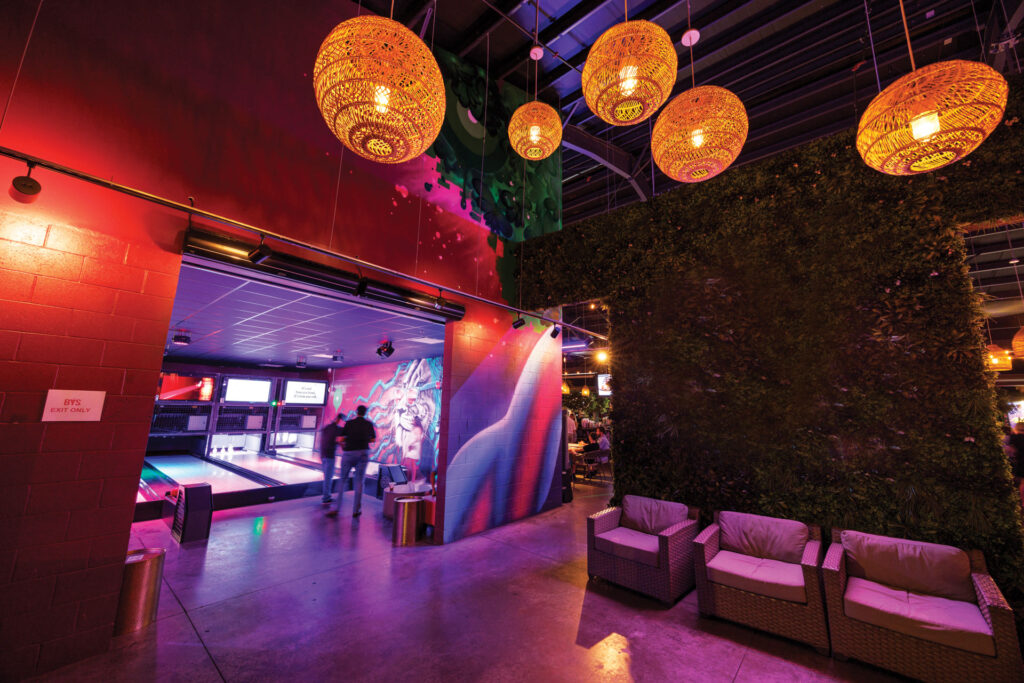 A slate of events and activities fills food truck parks’ calendars—from the seasonal maker markets at Backyard Social (above) to the dance nights at Bay Street Yard to the Wooftop Wednesdays for dog lovers at Bonita’s Rooftop at Riverside. Photography by Brian Tietz[/caption]
A slate of events and activities fills food truck parks’ calendars—from the seasonal maker markets at Backyard Social (above) to the dance nights at Bay Street Yard to the Wooftop Wednesdays for dog lovers at Bonita’s Rooftop at Riverside. Photography by Brian Tietz[/caption]
Beyond touting contemporary architecture, striking public art and built-in social games, the venues pump out a wealth of high-quality cuisine. Pick a table at any of these locales, and you’ll be surrounded by a range of skilled home cooks-turned-restaurateurs, barbecue masters in the making and classically trained chefs testing their next ventures. And, each truck offers something distinct.
At Backyard’s No Manches, self-taught Peruvian chef Vanessa Franco Goñi infuses her homeland’s flavors into familiar Mexican dishes for inspired creations like quesabirria bao buns and pork carnitas tacos stuffed in fresh-pressed blue corn tortillas (which Vanessa picks up daily from Tortilleria La Guera in Lehigh Acres). “Cooking my food means independence and doing my own thing,” she says. A few trucks over, Fort Myers-raised, mid-twenties Tyler Goguen brings Central Texas craft-style ’cue to the game with Beau’s BBQ. Thick slabs of beef ribs and brisket by the pound (with a simple dry rub smoked low-and-slow for 15 hours over post oak wood) dance out of the truck alongside soft slices of white bread, pickles and paper boats brimming with picnic sides.
[caption id="attachment_71901" align="aligncenter" width="850"]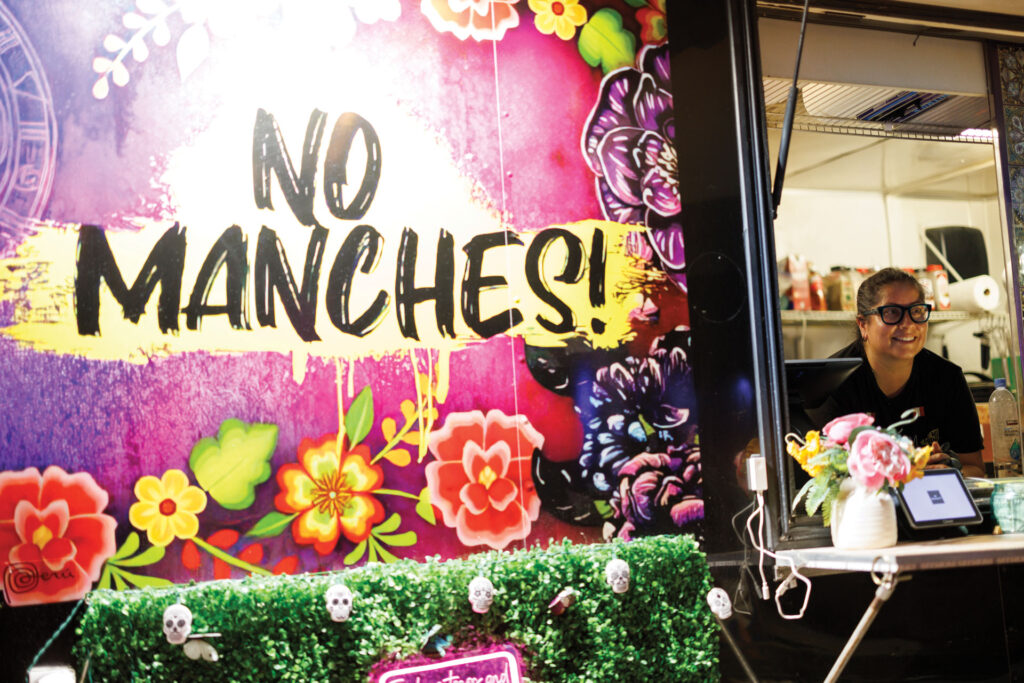 Chefs revel in the creative challenge of serving from a 120-square-foot food truck. The need for experimentation leads to dishes like quesabirria bao buns at the Mexican-Peruvian No Manches truck at Fort Myers’ Backyard Social. Photography by Brian Tietz[/caption]
Chefs revel in the creative challenge of serving from a 120-square-foot food truck. The need for experimentation leads to dishes like quesabirria bao buns at the Mexican-Peruvian No Manches truck at Fort Myers’ Backyard Social. Photography by Brian Tietz[/caption]
Chefs appreciate the creative challenges and freedom of cooking in a 120-square-foot truck. Having no set restaurant menu to occlude the imagination has drawn big-name restaurateurs, like 21 Spices’ Asif Sayed and the Neri family, owners of Naples’ beloved Molto Trattoria. Both restaurateurs have satellite locations at Celebration with blessedly stripped-down versions of their established fine-dining menus (think: roasted lamb naan flatbreads with mint chutney at Asif’s Deccani Bites and classic, deep-fried arancini rice balls at Molto Street Food).
With more options at your fingertips, it’s easy to find something to satisfy everyone—even restricted eaters. The gluten-adverse find pie heaven at Rooftop at Riverside’s Zoey’s Pizza, from father-daughter duo Doug and Zoey Lester. Born partly out of necessity (Zoey has celiac disease), the Lesters’ menu of gluten-free pizzas (plus, free-range chicken wings and salads) relies on flour imported from Italy and recipes informed by Doug’s experience as a Le Cordon Bleu Australia-trained chef.
Not feeling pizza that day? Go to any of the other trucks around Zoey’s for po’ boys with Gulf-caught shrimp at OCN Seafood Co.; savory galettes and sweet crêpes from the French-run Ma Petite Crêperie; and small-batch wholesome and booze-spiked ice cream at Crooked Cow Creamery.
[caption id="attachment_71902" align="aligncenter" width="850"]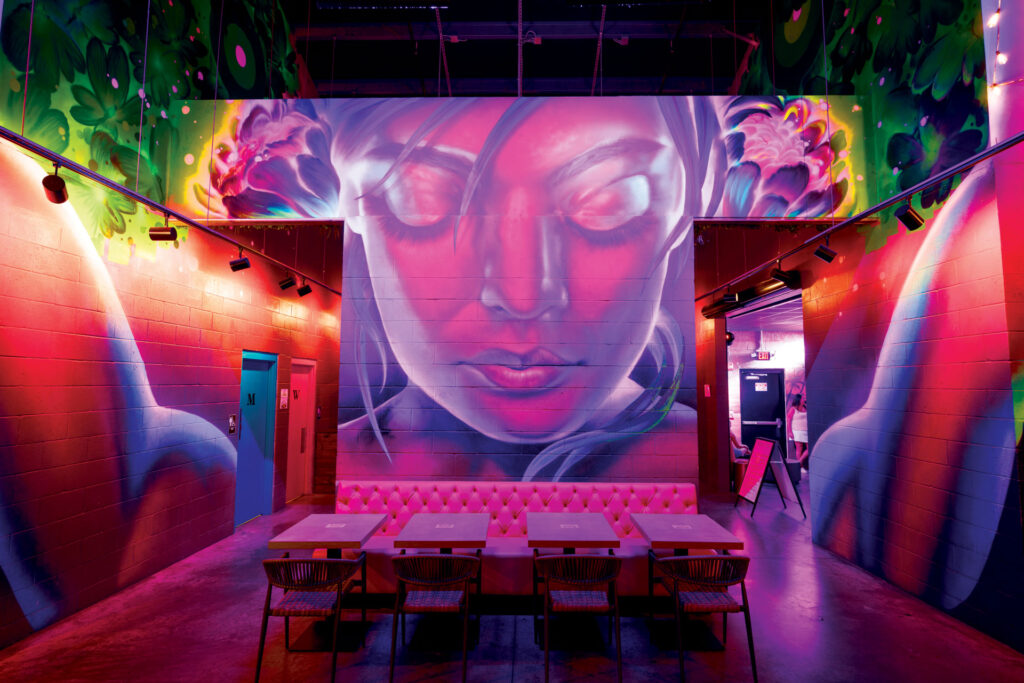 Backyard Social’s clubby atmosphere—filled with psychedelic murals, old-school games and neon signs—reflects the decidedly youthful tilt of the food truck park craze. Photography by Brian Tietz[/caption]
Backyard Social’s clubby atmosphere—filled with psychedelic murals, old-school games and neon signs—reflects the decidedly youthful tilt of the food truck park craze. Photography by Brian Tietz[/caption]
The vibe within these ‘eatertainment centers’—as Backyard Social’s co-owner Mat Baum calls food truck parks—is decidedly youthful. Backyard exudes the energy of a hip Miami club, with its sprightly, 1980s-inspired synth-wave aesthetic (psychedelic murals, old-school games, neon signs). “There’s no pressure—it allows for people to relax and do what they think is fun,” Mat says.
Rooftop at Riverside celebrates a local sense of place, with its beach house-like, two-story site housing the only rooftop bar in Bonita. Owner Chris Magnus honors his hometown’s heritage on the walls, with relics from the Bonita Springs Historical Society, and on the cocktail menu, developed by TV show Bar Rescue cohost Phil Wills. Special drinks nod to local landmarks and icons like the Belle Myers gin cooler, named after a 1900s ferry that went to and from Downtown Bonita. “People were worried about losing our small-town charm and [having] overdevelopment, so we said, ‘Let’s listen to the people,” Chris says. “Our history in Bonita Springs isn’t really old, but it is really cool.”
To foster a sense of community and make good on food truck parks’ experiential promise, Chris maintains a steady lineup of events, including bingo nights and the charming Wooftop Wednesdays, with dog meals at each truck.
[caption id="attachment_71903" align="aligncenter" width="850"]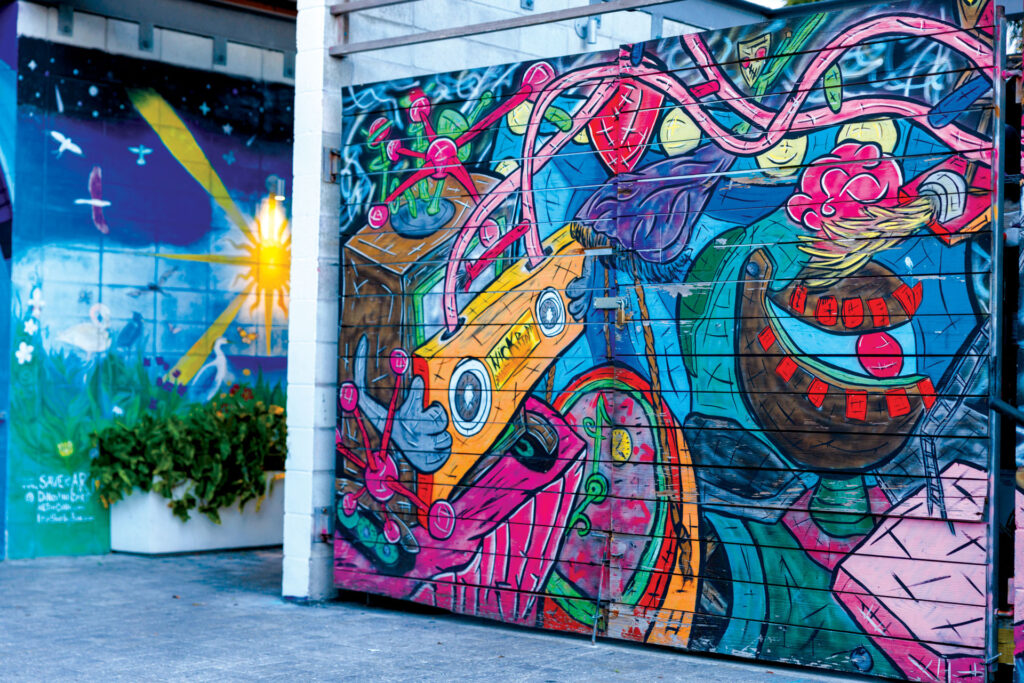 Celebration Park blazed the trail for Southwest Florida food truck parks in 2018 when it opened in Naples’ Bayshore corridor, fueling the neighborhood’s artful revitalization. Photography by Brian Tietz[/caption]
Celebration Park blazed the trail for Southwest Florida food truck parks in 2018 when it opened in Naples’ Bayshore corridor, fueling the neighborhood’s artful revitalization. Photography by Brian Tietz[/caption]
Entertainment and community are built into the fabric of all the parks, evidenced by the omnipresence of ping-pong tables, cornhole sets and socializing nooks. Fort Myers’ newer Bay Street Yard revolves around its outdoor stage, which hosts live music and has a big screen for sporting events. Renowned Fort Myers-based modernist architect Joyce Owens designed the showpiece venue, using shipping containers for the two bars and bathrooms (with a communal trough sink between) and the upstairs VIP platform. “There are all kinds of different spaces—the lawn with Adirondacks and high-tops; the covered seating area between the bars; upstairs, which has three curtained-off ‘suites’ you can reserve and a rail overlooking the stage,” Joyce says. The warehouse-chic space, across the street from Luminary Hotel & Co., solidifies the area’s reputation as a culinary hub, with three distinct food trucks painted to match Bay Street’s vibe.
Just like Celebration and Rooftop at Riverside are benchmarks for their neighborhoods’ revitalization, Bay Street fosters Downtown Fort Myers’ return as a dynamic urban center. “What’s nice is it’s a contained urban site,” Joyce says. Chance encounters by the trough sink and under the covered bar lead to friendships, lovers groove along to live music (the open-concept, alfresco setting means there’s plenty of room to boogie) and families let children roam free, knowing intrepid tykes can’t venture beyond Bay Street’s strategically walled-in perimeter. “It brings people closer together,” Joyce says. “Like every great party, it’s not spread out.”
[ngg src="galleries" ids="434" display="imagebrowser"]
The post Food Truck Parks Take Over SWFL—Here’s Where to Find the Best Eats appeared first on Gulfshore Life.
]]> A slate of events and activities fills food truck parks’ calendars—from the seasonal maker markets at Backyard Social (above) to the dance nights at Bay Street Yard to the Wooftop Wednesdays for dog lovers at Bonita’s Rooftop at Riverside. Photography by Brian Tietz[/caption]
Beyond touting contemporary architecture, striking public art and built-in social games, the venues pump out a wealth of high-quality cuisine. Pick a table at any of these locales, and you’ll be surrounded by a range of skilled home cooks-turned-restaurateurs, barbecue masters in the making and classically trained chefs testing their next ventures. And, each truck offers something distinct.
At Backyard’s No Manches, self-taught Peruvian chef Vanessa Franco Goñi infuses her homeland’s flavors into familiar Mexican dishes for inspired creations like quesabirria bao buns and pork carnitas tacos stuffed in fresh-pressed blue corn tortillas (which Vanessa picks up daily from Tortilleria La Guera in Lehigh Acres). “Cooking my food means independence and doing my own thing,” she says. A few trucks over, Fort Myers-raised, mid-twenties Tyler Goguen brings Central Texas craft-style ’cue to the game with Beau’s BBQ. Thick slabs of beef ribs and brisket by the pound (with a simple dry rub smoked low-and-slow for 15 hours over post oak wood) dance out of the truck alongside soft slices of white bread, pickles and paper boats brimming with picnic sides.
[caption id="attachment_71901" align="aligncenter" width="850"]
A slate of events and activities fills food truck parks’ calendars—from the seasonal maker markets at Backyard Social (above) to the dance nights at Bay Street Yard to the Wooftop Wednesdays for dog lovers at Bonita’s Rooftop at Riverside. Photography by Brian Tietz[/caption]
Beyond touting contemporary architecture, striking public art and built-in social games, the venues pump out a wealth of high-quality cuisine. Pick a table at any of these locales, and you’ll be surrounded by a range of skilled home cooks-turned-restaurateurs, barbecue masters in the making and classically trained chefs testing their next ventures. And, each truck offers something distinct.
At Backyard’s No Manches, self-taught Peruvian chef Vanessa Franco Goñi infuses her homeland’s flavors into familiar Mexican dishes for inspired creations like quesabirria bao buns and pork carnitas tacos stuffed in fresh-pressed blue corn tortillas (which Vanessa picks up daily from Tortilleria La Guera in Lehigh Acres). “Cooking my food means independence and doing my own thing,” she says. A few trucks over, Fort Myers-raised, mid-twenties Tyler Goguen brings Central Texas craft-style ’cue to the game with Beau’s BBQ. Thick slabs of beef ribs and brisket by the pound (with a simple dry rub smoked low-and-slow for 15 hours over post oak wood) dance out of the truck alongside soft slices of white bread, pickles and paper boats brimming with picnic sides.
[caption id="attachment_71901" align="aligncenter" width="850"] Chefs revel in the creative challenge of serving from a 120-square-foot food truck. The need for experimentation leads to dishes like quesabirria bao buns at the Mexican-Peruvian No Manches truck at Fort Myers’ Backyard Social. Photography by Brian Tietz[/caption]
Chefs appreciate the creative challenges and freedom of cooking in a 120-square-foot truck. Having no set restaurant menu to occlude the imagination has drawn big-name restaurateurs, like 21 Spices’ Asif Sayed and the Neri family, owners of Naples’ beloved Molto Trattoria. Both restaurateurs have satellite locations at Celebration with blessedly stripped-down versions of their established fine-dining menus (think: roasted lamb naan flatbreads with mint chutney at Asif’s Deccani Bites and classic, deep-fried arancini rice balls at Molto Street Food).
With more options at your fingertips, it’s easy to find something to satisfy everyone—even restricted eaters. The gluten-adverse find pie heaven at Rooftop at Riverside’s Zoey’s Pizza, from father-daughter duo Doug and Zoey Lester. Born partly out of necessity (Zoey has celiac disease), the Lesters’ menu of gluten-free pizzas (plus, free-range chicken wings and salads) relies on flour imported from Italy and recipes informed by Doug’s experience as a Le Cordon Bleu Australia-trained chef.
Not feeling pizza that day? Go to any of the other trucks around Zoey’s for po’ boys with Gulf-caught shrimp at OCN Seafood Co.; savory galettes and sweet crêpes from the French-run Ma Petite Crêperie; and small-batch wholesome and booze-spiked ice cream at Crooked Cow Creamery.
[caption id="attachment_71902" align="aligncenter" width="850"]
Chefs revel in the creative challenge of serving from a 120-square-foot food truck. The need for experimentation leads to dishes like quesabirria bao buns at the Mexican-Peruvian No Manches truck at Fort Myers’ Backyard Social. Photography by Brian Tietz[/caption]
Chefs appreciate the creative challenges and freedom of cooking in a 120-square-foot truck. Having no set restaurant menu to occlude the imagination has drawn big-name restaurateurs, like 21 Spices’ Asif Sayed and the Neri family, owners of Naples’ beloved Molto Trattoria. Both restaurateurs have satellite locations at Celebration with blessedly stripped-down versions of their established fine-dining menus (think: roasted lamb naan flatbreads with mint chutney at Asif’s Deccani Bites and classic, deep-fried arancini rice balls at Molto Street Food).
With more options at your fingertips, it’s easy to find something to satisfy everyone—even restricted eaters. The gluten-adverse find pie heaven at Rooftop at Riverside’s Zoey’s Pizza, from father-daughter duo Doug and Zoey Lester. Born partly out of necessity (Zoey has celiac disease), the Lesters’ menu of gluten-free pizzas (plus, free-range chicken wings and salads) relies on flour imported from Italy and recipes informed by Doug’s experience as a Le Cordon Bleu Australia-trained chef.
Not feeling pizza that day? Go to any of the other trucks around Zoey’s for po’ boys with Gulf-caught shrimp at OCN Seafood Co.; savory galettes and sweet crêpes from the French-run Ma Petite Crêperie; and small-batch wholesome and booze-spiked ice cream at Crooked Cow Creamery.
[caption id="attachment_71902" align="aligncenter" width="850"] Backyard Social’s clubby atmosphere—filled with psychedelic murals, old-school games and neon signs—reflects the decidedly youthful tilt of the food truck park craze. Photography by Brian Tietz[/caption]
The vibe within these ‘eatertainment centers’—as Backyard Social’s co-owner Mat Baum calls food truck parks—is decidedly youthful. Backyard exudes the energy of a hip Miami club, with its sprightly, 1980s-inspired synth-wave aesthetic (psychedelic murals, old-school games, neon signs). “There’s no pressure—it allows for people to relax and do what they think is fun,” Mat says.
Rooftop at Riverside celebrates a local sense of place, with its beach house-like, two-story site housing the only rooftop bar in Bonita. Owner Chris Magnus honors his hometown’s heritage on the walls, with relics from the Bonita Springs Historical Society, and on the cocktail menu, developed by TV show Bar Rescue cohost Phil Wills. Special drinks nod to local landmarks and icons like the Belle Myers gin cooler, named after a 1900s ferry that went to and from Downtown Bonita. “People were worried about losing our small-town charm and [having] overdevelopment, so we said, ‘Let’s listen to the people,” Chris says. “Our history in Bonita Springs isn’t really old, but it is really cool.”
To foster a sense of community and make good on food truck parks’ experiential promise, Chris maintains a steady lineup of events, including bingo nights and the charming Wooftop Wednesdays, with dog meals at each truck.
[caption id="attachment_71903" align="aligncenter" width="850"]
Backyard Social’s clubby atmosphere—filled with psychedelic murals, old-school games and neon signs—reflects the decidedly youthful tilt of the food truck park craze. Photography by Brian Tietz[/caption]
The vibe within these ‘eatertainment centers’—as Backyard Social’s co-owner Mat Baum calls food truck parks—is decidedly youthful. Backyard exudes the energy of a hip Miami club, with its sprightly, 1980s-inspired synth-wave aesthetic (psychedelic murals, old-school games, neon signs). “There’s no pressure—it allows for people to relax and do what they think is fun,” Mat says.
Rooftop at Riverside celebrates a local sense of place, with its beach house-like, two-story site housing the only rooftop bar in Bonita. Owner Chris Magnus honors his hometown’s heritage on the walls, with relics from the Bonita Springs Historical Society, and on the cocktail menu, developed by TV show Bar Rescue cohost Phil Wills. Special drinks nod to local landmarks and icons like the Belle Myers gin cooler, named after a 1900s ferry that went to and from Downtown Bonita. “People were worried about losing our small-town charm and [having] overdevelopment, so we said, ‘Let’s listen to the people,” Chris says. “Our history in Bonita Springs isn’t really old, but it is really cool.”
To foster a sense of community and make good on food truck parks’ experiential promise, Chris maintains a steady lineup of events, including bingo nights and the charming Wooftop Wednesdays, with dog meals at each truck.
[caption id="attachment_71903" align="aligncenter" width="850"] Celebration Park blazed the trail for Southwest Florida food truck parks in 2018 when it opened in Naples’ Bayshore corridor, fueling the neighborhood’s artful revitalization. Photography by Brian Tietz[/caption]
Entertainment and community are built into the fabric of all the parks, evidenced by the omnipresence of ping-pong tables, cornhole sets and socializing nooks. Fort Myers’ newer Bay Street Yard revolves around its outdoor stage, which hosts live music and has a big screen for sporting events. Renowned Fort Myers-based modernist architect Joyce Owens designed the showpiece venue, using shipping containers for the two bars and bathrooms (with a communal trough sink between) and the upstairs VIP platform. “There are all kinds of different spaces—the lawn with Adirondacks and high-tops; the covered seating area between the bars; upstairs, which has three curtained-off ‘suites’ you can reserve and a rail overlooking the stage,” Joyce says. The warehouse-chic space, across the street from Luminary Hotel & Co., solidifies the area’s reputation as a culinary hub, with three distinct food trucks painted to match Bay Street’s vibe.
Just like Celebration and Rooftop at Riverside are benchmarks for their neighborhoods’ revitalization, Bay Street fosters Downtown Fort Myers’ return as a dynamic urban center. “What’s nice is it’s a contained urban site,” Joyce says. Chance encounters by the trough sink and under the covered bar lead to friendships, lovers groove along to live music (the open-concept, alfresco setting means there’s plenty of room to boogie) and families let children roam free, knowing intrepid tykes can’t venture beyond Bay Street’s strategically walled-in perimeter. “It brings people closer together,” Joyce says. “Like every great party, it’s not spread out.”
[ngg src="galleries" ids="434" display="imagebrowser"]
Celebration Park blazed the trail for Southwest Florida food truck parks in 2018 when it opened in Naples’ Bayshore corridor, fueling the neighborhood’s artful revitalization. Photography by Brian Tietz[/caption]
Entertainment and community are built into the fabric of all the parks, evidenced by the omnipresence of ping-pong tables, cornhole sets and socializing nooks. Fort Myers’ newer Bay Street Yard revolves around its outdoor stage, which hosts live music and has a big screen for sporting events. Renowned Fort Myers-based modernist architect Joyce Owens designed the showpiece venue, using shipping containers for the two bars and bathrooms (with a communal trough sink between) and the upstairs VIP platform. “There are all kinds of different spaces—the lawn with Adirondacks and high-tops; the covered seating area between the bars; upstairs, which has three curtained-off ‘suites’ you can reserve and a rail overlooking the stage,” Joyce says. The warehouse-chic space, across the street from Luminary Hotel & Co., solidifies the area’s reputation as a culinary hub, with three distinct food trucks painted to match Bay Street’s vibe.
Just like Celebration and Rooftop at Riverside are benchmarks for their neighborhoods’ revitalization, Bay Street fosters Downtown Fort Myers’ return as a dynamic urban center. “What’s nice is it’s a contained urban site,” Joyce says. Chance encounters by the trough sink and under the covered bar lead to friendships, lovers groove along to live music (the open-concept, alfresco setting means there’s plenty of room to boogie) and families let children roam free, knowing intrepid tykes can’t venture beyond Bay Street’s strategically walled-in perimeter. “It brings people closer together,” Joyce says. “Like every great party, it’s not spread out.”
[ngg src="galleries" ids="434" display="imagebrowser"]The post Food Truck Parks Take Over SWFL—Here’s Where to Find the Best Eats appeared first on Gulfshore Life.
]]>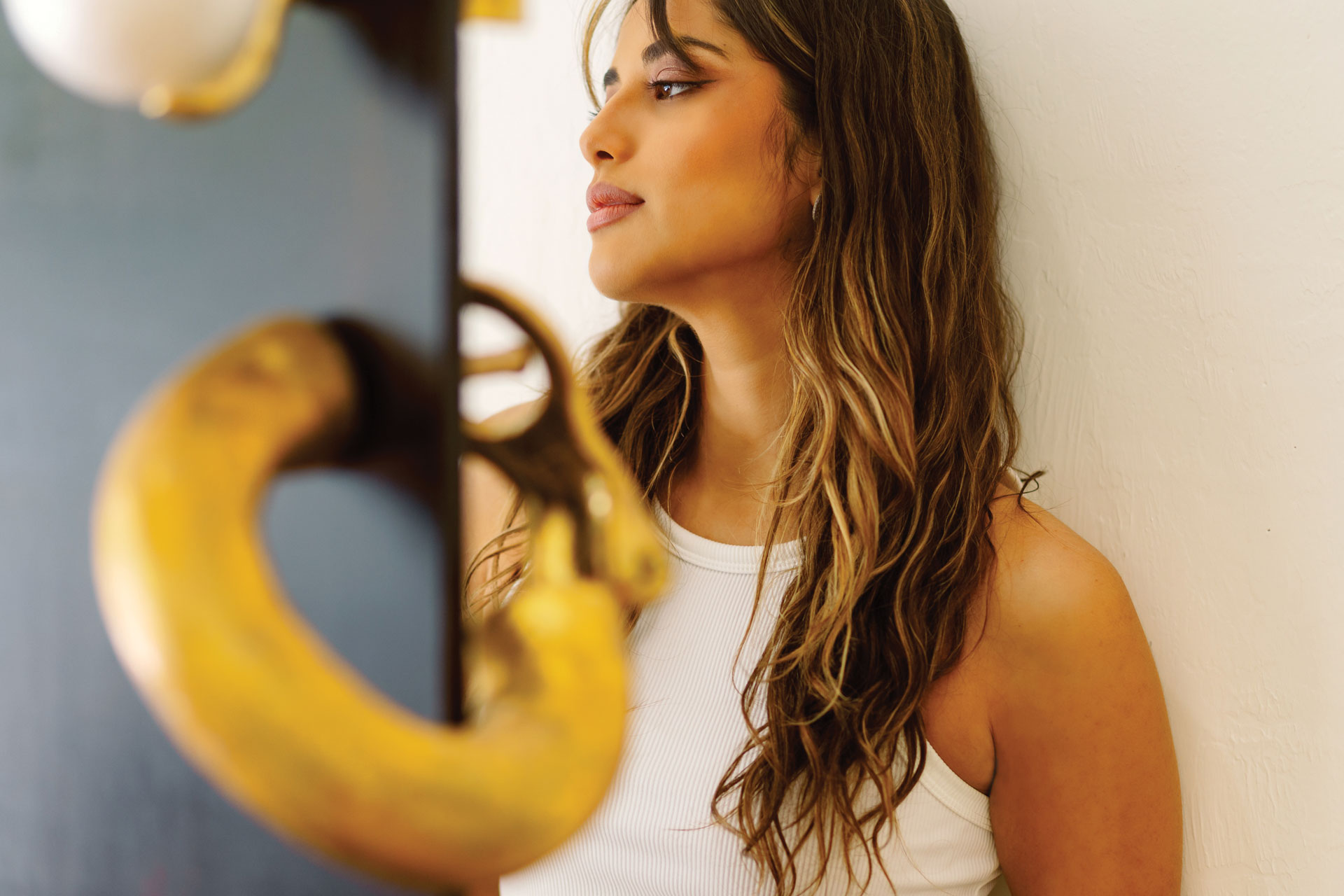
Alina Rubio is in constant communication with her future self. “I take my 45-year-old self out to coffee,” says the 29-year-old sculptor and owner of southeast Naples’ art studio and creative workspace, MasterPeace. “I talk to her about who she is, what she looks like, feels like, even what her house, furniture and art collection looks like—I hope she has a super cool art collection.” Treating her imagined future like a present reality helps Alina understand what she wants out of life and pursue her goals with intention.
The Miami native has often felt the pull of her older, wiser self at turning points in her journey. During her college years, Alina befriended a fellow artist and introduced herself as a sculptor. There was just one problem—she’d never sculpted before. But, the voice inside compelled her to try. That night, Alina went home and created her first sculpture—a silhouette of a woman carved into wood. Years later, after a stint as a gallerist and art adviser at Miami’s blue-chip Opera Gallery, she felt the pull again. This time, the now-bonafide sculptor was visiting Naples for an art fair and stumbled across the quirky, A-framed shopping complex off Tamiami Trail that became MasterPeace.
[caption id="attachment_71888" align="aligncenter" width="850"]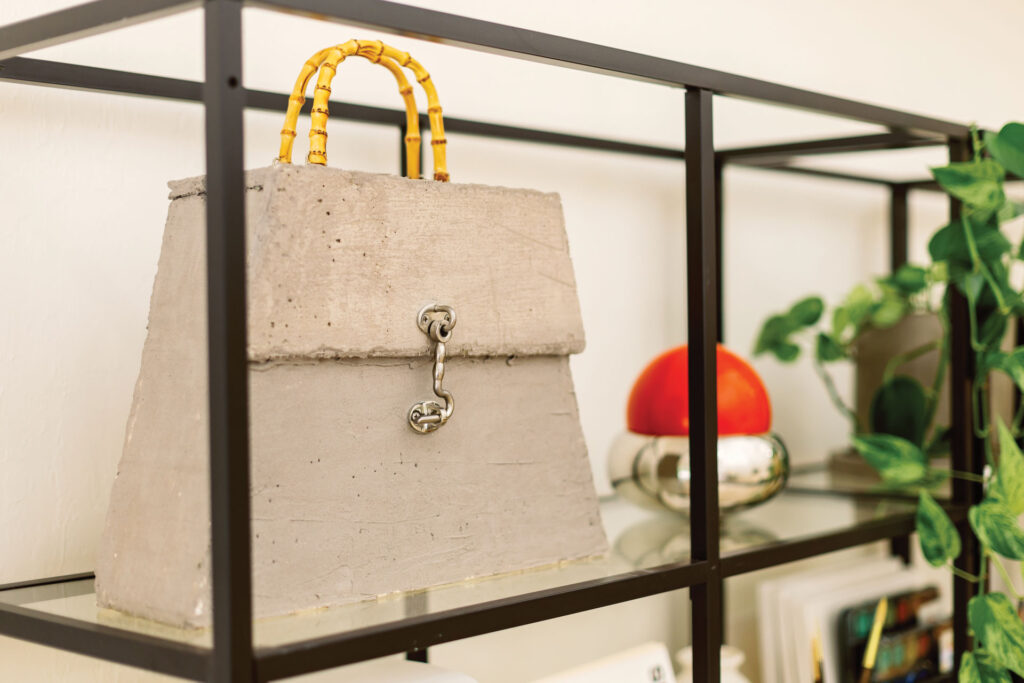 Alina Rubio combines her passions for art, wellness, design, music and education at MasterPeace, a Naples-based studio workshop offering weekly classes, where people at any skill level can embrace creativity. Photography by Christina Bankson[/caption]
Alina Rubio combines her passions for art, wellness, design, music and education at MasterPeace, a Naples-based studio workshop offering weekly classes, where people at any skill level can embrace creativity. Photography by Christina Bankson[/caption]
Alina set up shop in Naples in May of 2023 to create a safe space where anyone can reflect and explore their creativity through the arts. She is not an art therapist, but Alina’s classes mirror the practice’s principal ideas. “A lot of wellness comes from dedicating a little time to ourselves, whether by drinking more water, going for a walk, listening to music or writing in your journal. MasterPeace is just like an extension of that idea,” she says. In this stylishly serene, open-concept space, the sculptor blends her experience in the Miami fine arts world with her interests in the arts, wellness and education, offering art workshops weekly (and private events) suited for any skill level.
Each workshop is a bit different: One week may combine working with clay and doing yoga with Kim Quan from The Flow Body yoga studio, while the next might be painting and listening to live music from local musicians and Florida Gulf Coast University students. Each class is tailored to foster community and creative ‘flow.’ “For my dad, ‘flow’ has been an important word,” Alina says of the unbridled state of focus and inspiration often described by artists. “It’s like time is slow and fast at the same time and you are just connected.” Throughout her life, Alina watched her parents—her dad is a first-generation Cuban American; her mom emigrated from Venezuela after Alina was born—push through hardships and build successful businesses. Even in the midst of turmoil, her dad tended a lush garden. It kept him centered and present. Through years of reading psychology journals and plumbing anecdotal evidence shared by other creatives, Alina realized being present is the key to mastering creative flow—though that may be easier said than done. “Oftentimes, we get in our heads thinking about the future or the past,” she says. “I’m very guilty of doing that, and with the flow state, it really brings you into a moment of absolute presence in the now.”
[caption id="attachment_71889" align="aligncenter" width="683"]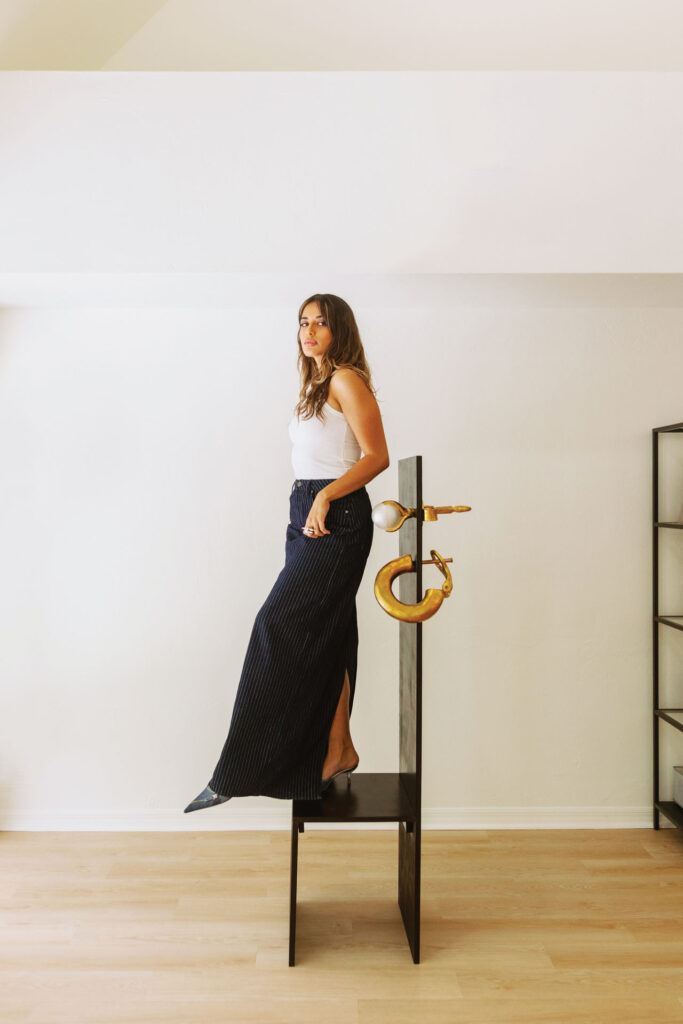 The MasterPeace owner and sculptor displays some of her heritage-inspired creations, such as Chair with Pearl Earring, in the studio. The minimalist, high-back chair is adorned with an oversized stud and hoop, representing the sentimental weight of family heirlooms. Photography by Christina Bankson[/caption]
The MasterPeace owner and sculptor displays some of her heritage-inspired creations, such as Chair with Pearl Earring, in the studio. The minimalist, high-back chair is adorned with an oversized stud and hoop, representing the sentimental weight of family heirlooms. Photography by Christina Bankson[/caption]
Alina earned a degree in early childhood education and a minor in fine arts from Florida International University (FIU) in 2018. There, she studied under renowned Miami sculptor Robert Chambers and found refuge in the fifth-floor library. An avid reader, Alina is fascinated by the psychology behind creativity—how it impacts people, relationships and society. Combining this fascination with her studies of teaching methods like Reggio Emilia (a curiosity-driven approach to education out of Italy that is similar to the Montessori method), the MasterPeace maven aims to expose more people to the benefits of investing in the artistic side of their brain in a no-pressure environment, so her students can be more present and tapped in with their inner selves. “It’s a very constructivist teaching style, which means that it is really led by the student and not necessarily led by the teacher. So, I don’t tell you what to do. You tell me what you’re interested in, and we work from there,” Alina says.
While the sculptor looks to her future self for courage, she calls on her past for inspiration. The MasterPeace studio is lined with sculptures and works-in-progress deeply rooted in familial relationships and history. Alina refers to some of her pieces, like Chair with Pearl Earring, as ‘sculptural heirlooms.’ The sturdy wooden chair, seemingly pierced with an oversized pearl stud, signifies the act of passing down an object imbued with memories and sentimental meaning. Recently, she has started producing ‘sculptural poems,’ a series of life-sized shadow boxes that display hand-made sculptures symbolic of her unique connection with specific family members and loved ones.
[caption id="attachment_71890" align="aligncenter" width="683"]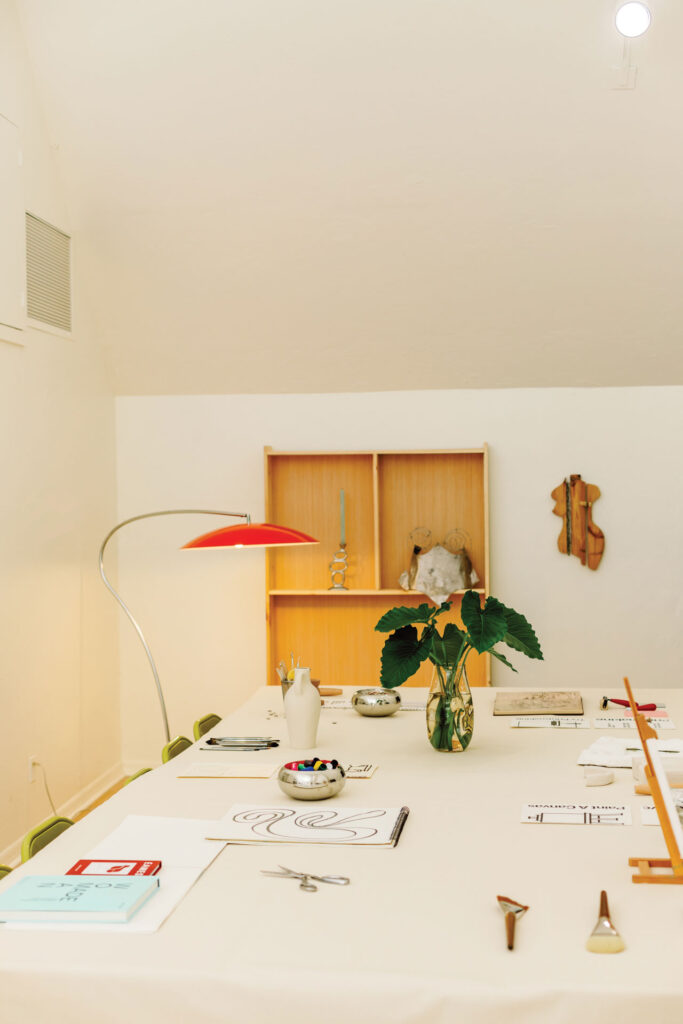 Alina follows a creativity- and curiosity-driven Reggio Emilia-inspired teaching method for her ever-evolving workshops. Themes like yoga and pottery set the stage for inspiration, and Alina offers guidance, but students create freely in a no-pressure environment. Photography by Christina Bankson[/caption]
Alina follows a creativity- and curiosity-driven Reggio Emilia-inspired teaching method for her ever-evolving workshops. Themes like yoga and pottery set the stage for inspiration, and Alina offers guidance, but students create freely in a no-pressure environment. Photography by Christina Bankson[/caption]
MasterPeace itself is something of a living artwork, underscoring the significance of creativity in every aspect of our lives while weaving together all of Alina’s callings. “Growing up, it always felt like society was putting some kind of rock on my shoulders, telling me I had to pick just one,” Alina says. “ [MasterPeace] pulls together all the things that I have ever loved. This is the poetry. It’s the music. It’s the sculpture. It’s the art. It’s the wellness. It’s the therapy. This is everything.”
[ngg src="galleries" ids="433" display="basic_thumbnail" thumbnail_crop="0"]
The post Naples’ Best New Art Workshop appeared first on Gulfshore Life.
]]> Alina Rubio is in constant communication with her future self. “I take my 45-year-old self out to coffee,” says the 29-year-old sculptor and owner of southeast Naples’ art studio and creative workspace, MasterPeace. “I talk to her about who she is, what she looks like, feels like, even what her house, furniture and art collection looks like—I hope she has a super cool art collection.” Treating her imagined future like a present reality helps Alina understand what she wants out of life and pursue her goals with intention.
The Miami native has often felt the pull of her older, wiser self at turning points in her journey. During her college years, Alina befriended a fellow artist and introduced herself as a sculptor. There was just one problem—she’d never sculpted before. But, the voice inside compelled her to try. That night, Alina went home and created her first sculpture—a silhouette of a woman carved into wood. Years later, after a stint as a gallerist and art adviser at Miami’s blue-chip Opera Gallery, she felt the pull again. This time, the now-bonafide sculptor was visiting Naples for an art fair and stumbled across the quirky, A-framed shopping complex off Tamiami Trail that became MasterPeace.
[caption id="attachment_71888" align="aligncenter" width="850"]
Alina Rubio is in constant communication with her future self. “I take my 45-year-old self out to coffee,” says the 29-year-old sculptor and owner of southeast Naples’ art studio and creative workspace, MasterPeace. “I talk to her about who she is, what she looks like, feels like, even what her house, furniture and art collection looks like—I hope she has a super cool art collection.” Treating her imagined future like a present reality helps Alina understand what she wants out of life and pursue her goals with intention.
The Miami native has often felt the pull of her older, wiser self at turning points in her journey. During her college years, Alina befriended a fellow artist and introduced herself as a sculptor. There was just one problem—she’d never sculpted before. But, the voice inside compelled her to try. That night, Alina went home and created her first sculpture—a silhouette of a woman carved into wood. Years later, after a stint as a gallerist and art adviser at Miami’s blue-chip Opera Gallery, she felt the pull again. This time, the now-bonafide sculptor was visiting Naples for an art fair and stumbled across the quirky, A-framed shopping complex off Tamiami Trail that became MasterPeace.
[caption id="attachment_71888" align="aligncenter" width="850"] Alina Rubio combines her passions for art, wellness, design, music and education at MasterPeace, a Naples-based studio workshop offering weekly classes, where people at any skill level can embrace creativity. Photography by Christina Bankson[/caption]
Alina set up shop in Naples in May of 2023 to create a safe space where anyone can reflect and explore their creativity through the arts. She is not an art therapist, but Alina’s classes mirror the practice’s principal ideas. “A lot of wellness comes from dedicating a little time to ourselves, whether by drinking more water, going for a walk, listening to music or writing in your journal. MasterPeace is just like an extension of that idea,” she says. In this stylishly serene, open-concept space, the sculptor blends her experience in the Miami fine arts world with her interests in the arts, wellness and education, offering art workshops weekly (and private events) suited for any skill level.
Each workshop is a bit different: One week may combine working with clay and doing yoga with Kim Quan from The Flow Body yoga studio, while the next might be painting and listening to live music from local musicians and Florida Gulf Coast University students. Each class is tailored to foster community and creative ‘flow.’ “For my dad, ‘flow’ has been an important word,” Alina says of the unbridled state of focus and inspiration often described by artists. “It’s like time is slow and fast at the same time and you are just connected.” Throughout her life, Alina watched her parents—her dad is a first-generation Cuban American; her mom emigrated from Venezuela after Alina was born—push through hardships and build successful businesses. Even in the midst of turmoil, her dad tended a lush garden. It kept him centered and present. Through years of reading psychology journals and plumbing anecdotal evidence shared by other creatives, Alina realized being present is the key to mastering creative flow—though that may be easier said than done. “Oftentimes, we get in our heads thinking about the future or the past,” she says. “I’m very guilty of doing that, and with the flow state, it really brings you into a moment of absolute presence in the now.”
[caption id="attachment_71889" align="aligncenter" width="683"]
Alina Rubio combines her passions for art, wellness, design, music and education at MasterPeace, a Naples-based studio workshop offering weekly classes, where people at any skill level can embrace creativity. Photography by Christina Bankson[/caption]
Alina set up shop in Naples in May of 2023 to create a safe space where anyone can reflect and explore their creativity through the arts. She is not an art therapist, but Alina’s classes mirror the practice’s principal ideas. “A lot of wellness comes from dedicating a little time to ourselves, whether by drinking more water, going for a walk, listening to music or writing in your journal. MasterPeace is just like an extension of that idea,” she says. In this stylishly serene, open-concept space, the sculptor blends her experience in the Miami fine arts world with her interests in the arts, wellness and education, offering art workshops weekly (and private events) suited for any skill level.
Each workshop is a bit different: One week may combine working with clay and doing yoga with Kim Quan from The Flow Body yoga studio, while the next might be painting and listening to live music from local musicians and Florida Gulf Coast University students. Each class is tailored to foster community and creative ‘flow.’ “For my dad, ‘flow’ has been an important word,” Alina says of the unbridled state of focus and inspiration often described by artists. “It’s like time is slow and fast at the same time and you are just connected.” Throughout her life, Alina watched her parents—her dad is a first-generation Cuban American; her mom emigrated from Venezuela after Alina was born—push through hardships and build successful businesses. Even in the midst of turmoil, her dad tended a lush garden. It kept him centered and present. Through years of reading psychology journals and plumbing anecdotal evidence shared by other creatives, Alina realized being present is the key to mastering creative flow—though that may be easier said than done. “Oftentimes, we get in our heads thinking about the future or the past,” she says. “I’m very guilty of doing that, and with the flow state, it really brings you into a moment of absolute presence in the now.”
[caption id="attachment_71889" align="aligncenter" width="683"] The MasterPeace owner and sculptor displays some of her heritage-inspired creations, such as Chair with Pearl Earring, in the studio. The minimalist, high-back chair is adorned with an oversized stud and hoop, representing the sentimental weight of family heirlooms. Photography by Christina Bankson[/caption]
Alina earned a degree in early childhood education and a minor in fine arts from Florida International University (FIU) in 2018. There, she studied under renowned Miami sculptor Robert Chambers and found refuge in the fifth-floor library. An avid reader, Alina is fascinated by the psychology behind creativity—how it impacts people, relationships and society. Combining this fascination with her studies of teaching methods like Reggio Emilia (a curiosity-driven approach to education out of Italy that is similar to the Montessori method), the MasterPeace maven aims to expose more people to the benefits of investing in the artistic side of their brain in a no-pressure environment, so her students can be more present and tapped in with their inner selves. “It’s a very constructivist teaching style, which means that it is really led by the student and not necessarily led by the teacher. So, I don’t tell you what to do. You tell me what you’re interested in, and we work from there,” Alina says.
While the sculptor looks to her future self for courage, she calls on her past for inspiration. The MasterPeace studio is lined with sculptures and works-in-progress deeply rooted in familial relationships and history. Alina refers to some of her pieces, like Chair with Pearl Earring, as ‘sculptural heirlooms.’ The sturdy wooden chair, seemingly pierced with an oversized pearl stud, signifies the act of passing down an object imbued with memories and sentimental meaning. Recently, she has started producing ‘sculptural poems,’ a series of life-sized shadow boxes that display hand-made sculptures symbolic of her unique connection with specific family members and loved ones.
[caption id="attachment_71890" align="aligncenter" width="683"]
The MasterPeace owner and sculptor displays some of her heritage-inspired creations, such as Chair with Pearl Earring, in the studio. The minimalist, high-back chair is adorned with an oversized stud and hoop, representing the sentimental weight of family heirlooms. Photography by Christina Bankson[/caption]
Alina earned a degree in early childhood education and a minor in fine arts from Florida International University (FIU) in 2018. There, she studied under renowned Miami sculptor Robert Chambers and found refuge in the fifth-floor library. An avid reader, Alina is fascinated by the psychology behind creativity—how it impacts people, relationships and society. Combining this fascination with her studies of teaching methods like Reggio Emilia (a curiosity-driven approach to education out of Italy that is similar to the Montessori method), the MasterPeace maven aims to expose more people to the benefits of investing in the artistic side of their brain in a no-pressure environment, so her students can be more present and tapped in with their inner selves. “It’s a very constructivist teaching style, which means that it is really led by the student and not necessarily led by the teacher. So, I don’t tell you what to do. You tell me what you’re interested in, and we work from there,” Alina says.
While the sculptor looks to her future self for courage, she calls on her past for inspiration. The MasterPeace studio is lined with sculptures and works-in-progress deeply rooted in familial relationships and history. Alina refers to some of her pieces, like Chair with Pearl Earring, as ‘sculptural heirlooms.’ The sturdy wooden chair, seemingly pierced with an oversized pearl stud, signifies the act of passing down an object imbued with memories and sentimental meaning. Recently, she has started producing ‘sculptural poems,’ a series of life-sized shadow boxes that display hand-made sculptures symbolic of her unique connection with specific family members and loved ones.
[caption id="attachment_71890" align="aligncenter" width="683"] Alina follows a creativity- and curiosity-driven Reggio Emilia-inspired teaching method for her ever-evolving workshops. Themes like yoga and pottery set the stage for inspiration, and Alina offers guidance, but students create freely in a no-pressure environment. Photography by Christina Bankson[/caption]
MasterPeace itself is something of a living artwork, underscoring the significance of creativity in every aspect of our lives while weaving together all of Alina’s callings. “Growing up, it always felt like society was putting some kind of rock on my shoulders, telling me I had to pick just one,” Alina says. “ [MasterPeace] pulls together all the things that I have ever loved. This is the poetry. It’s the music. It’s the sculpture. It’s the art. It’s the wellness. It’s the therapy. This is everything.”
[ngg src="galleries" ids="433" display="basic_thumbnail" thumbnail_crop="0"]
Alina follows a creativity- and curiosity-driven Reggio Emilia-inspired teaching method for her ever-evolving workshops. Themes like yoga and pottery set the stage for inspiration, and Alina offers guidance, but students create freely in a no-pressure environment. Photography by Christina Bankson[/caption]
MasterPeace itself is something of a living artwork, underscoring the significance of creativity in every aspect of our lives while weaving together all of Alina’s callings. “Growing up, it always felt like society was putting some kind of rock on my shoulders, telling me I had to pick just one,” Alina says. “ [MasterPeace] pulls together all the things that I have ever loved. This is the poetry. It’s the music. It’s the sculpture. It’s the art. It’s the wellness. It’s the therapy. This is everything.”
[ngg src="galleries" ids="433" display="basic_thumbnail" thumbnail_crop="0"]The post Naples’ Best New Art Workshop appeared first on Gulfshore Life.
]]>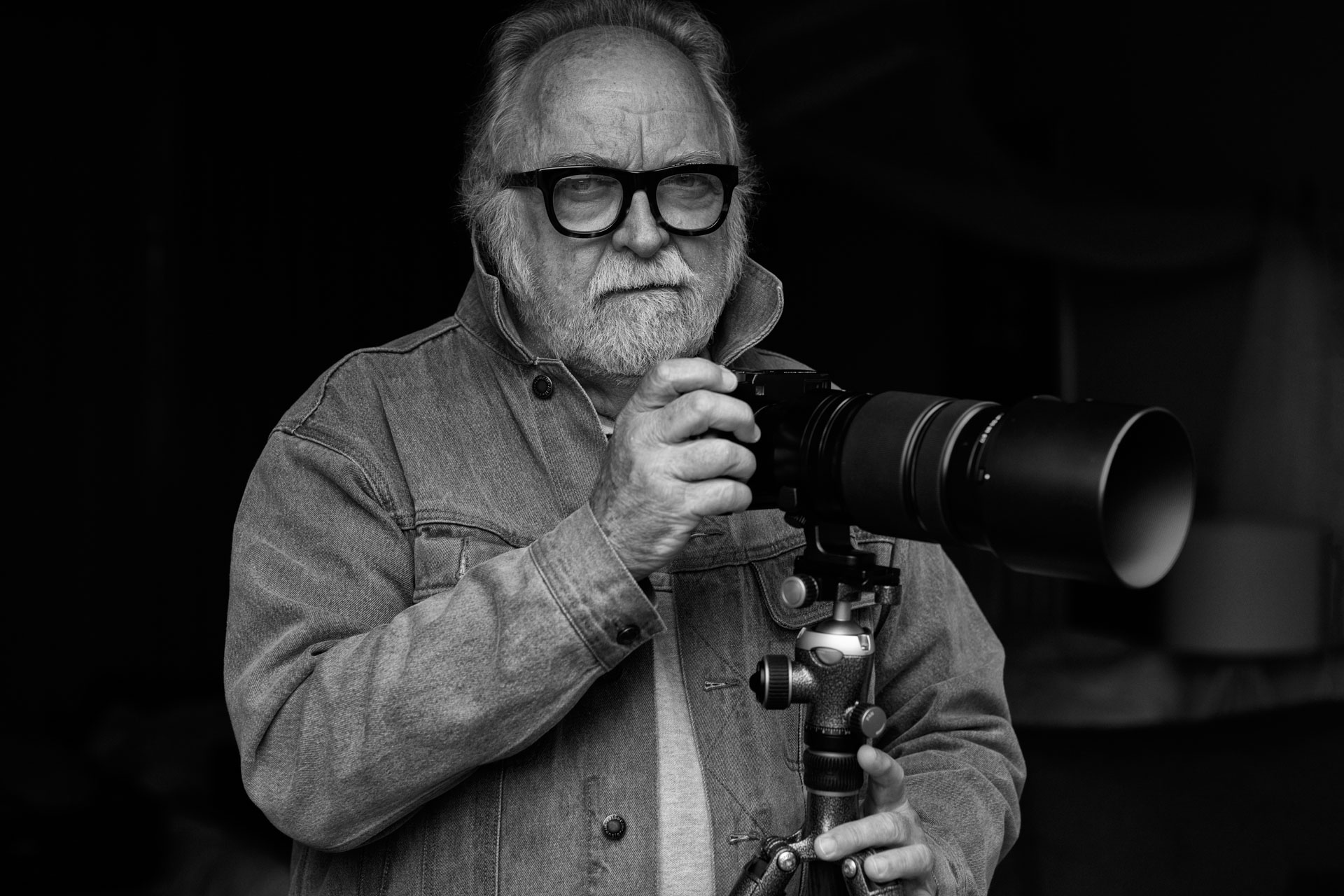
In April, photographer Harry De Zitter found himself standing in the middle of a road in his native South Africa. He was talking with a friend in the Karoo, an arid region covered with low scrub brushes. The open, umber-colored plains surrounding them reached into infinite stretches as another man approached. Harry’s focus drifted to the newcomer’s fraying boots and the dusty, shattered asphalt beneath. He couldn’t help but take a shot. The resulting black-and-white photograph is so sparse and candid that it becomes affectingly intimate.
Harry, who spends most of the year in Naples, has a decades-long career as an advertising photographer. He’s a titan in the industry, globetrotting to cover splashy campaigns for dozens of top-tier clients, ranging from Mercedes-Benz and Stella Artois to Wrangler and IBM. He’s photographed Paul McCartney and Bill Gates, run studios in New York City and London, and published work in Elle Italia and Conde Nast Traveler.
[caption id="attachment_70895" align="aligncenter" width="300"]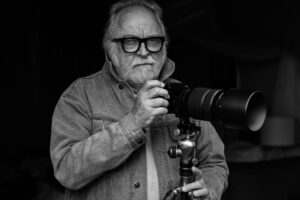 For his personal work, the advertising photographer titan shoots in grayscale. “Black and white gets at the reality of the place,” he says.[/caption]
For his personal work, the advertising photographer titan shoots in grayscale. “Black and white gets at the reality of the place,” he says.[/caption]
But, when it comes to his personal projects, Harry favors story-driven compositions in black and white. Images like the one he captured on that desert road this past spring, Worker with Well-Worn Boots, elevate the aloof or mundane into a haunting human treatise and distinguish the photographer as an artist. “My viewfinder is my window to the world,” he says.
[caption id="attachment_70894" align="alignleft" width="300"]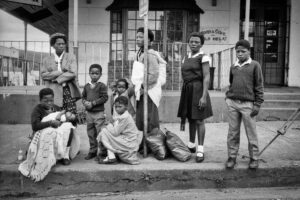 Family Waiting at Bus Stop, Natal, South Africa (1988)[/caption]
Family Waiting at Bus Stop, Natal, South Africa (1988)[/caption]
[caption id="attachment_70893" align="alignright" width="300"] Farm Landscape, Overberg, South Africa (2017)[/caption]
Farm Landscape, Overberg, South Africa (2017)[/caption]
Harry estimates that 90 percent of his work as an advertising photographer has been in color; his black-and-white photographs are all his—a fascination that’s stayed with him since college. He recalls the campus’ dark room and watching his first black-and-white shot come into focus under dim red light. “I was smitten,” he says. “It was magic.”
As his career in advertising photography coalesced, Harry kept returning to his monochromatic passions. It has cojones (nerve), he says of the grayscale palette. “It has texture; it has soul,” he adds, leaning forward in a burst of animation. “It reminds me of hearing a record producer talk about digital recordings, that they’re sometimes too clean. You need grit and noise.”
The absence of color, combined with Harry’s uncanny observational acumen, has yielded hundreds of black-and-white photos documenting people, places and possessions across the planet. In monochrome, Harry’s work is less encumbered by visual distractions, making his images sharper, starker. “Black and white gets at the reality of the place,” he says.
[caption id="attachment_70892" align="alignleft" width="300"] Worker with Well-Worn Boots, Middelpos, Karoo, South Africa (2024)[/caption]
Worker with Well-Worn Boots, Middelpos, Karoo, South Africa (2024)[/caption]
Look at his photographs like Chrysler Building and Empire State Building. The images capture New York City’s famed landmarks, not as chipper postcard scenes but almost ominously in their achromatic states—a reminder that there’s more grit than glamour in the city’s grind. The same pathos is palpable in his monochrome landscapes. In The Everglades, part of his Chasing Clouds series, the inky undersides of thunderheads swell forebodingly over the swamp’s horizon. “That image wouldn’t have the same power in color,” he says definitively.
Grayscale photography has a narrative quality, too, Harry says, particularly with human subjects. In the 2019 Grandmother Shopping with her Granddaughter at Thursday Market, Harry captures a tender moment amid the streets of Bassano del Grappa, a town in northern Italy. The double portrait narrows in on the pair’s interlocked arms and hands, cropping out their faces entirely. The generational gap is evident through their wardrobe—the granddaughter wears a baggy Adidas shirt; the grandmother, a tidy ensemble with a structured handbag—and the warmth is palpable with how they lean on each other. “I was moved by the granddaughter’s tenderness for her grandmother,” Harry says. “The act of her affectionately holding her grandmother’s arm, whereas most teenagers would be too embarrassed to be seen with their grandparent, [struck me].”
[caption id="attachment_70897" align="alignleft" width="300"]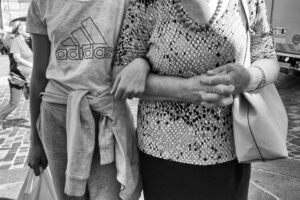 Grandmother Shopping with her Granddaughter at Thursday Market, Bassano del Grappa, Italy (2019)[/caption]
Grandmother Shopping with her Granddaughter at Thursday Market, Bassano del Grappa, Italy (2019)[/caption]
As they talked, the nonna told him that Lino Manfrotto, the founder of renowned photography and videography equipment company Manfrotto, had been her wedding photographer. She didn’t know Harry had been an ambassador and product tester for the brand for years, a partnership that continues to this day.
Born in Belgium, Harry and his family moved to South Africa’s Eastern Cape when he was 9 months old. At 18, he enrolled in the Port Elizabeth Art School (now part of Nelson Mandela University) and soon found work as an assistant in his professor’s son’s darkroom. “I’ve had to be very versatile,” Harry says. “In the United States and Europe, photographers specialize because there are so many people working in places like New York, London, Paris. But in South Africa, you had to do it all—cars, fashion, still life.”
Much of Harry’s South African photography serves as a documentation of his home as he knows it: interior shots of his brother’s workshop, portraits of longtime friends and prominent creatives, candid shots of locals in various parts of the country.
[caption id="attachment_70896" align="alignleft" width="300"] Chrysler Building, New York City, New York (1995)[/caption]
Chrysler Building, New York City, New York (1995)[/caption]
Amid these familial and fraternal frames are photographs like Family Waiting at Bus Stop. The arresting image, shot for Manfrotto, captures an African family of nine deep in the Zulu nation (one of South Africa’s native populations). The subjects seem to scrutinize the man behind the lens—the younger family members stare back, unabashed but slightly defensive, except for two: an infant and a young boy in a dark V-neck sweater. The boy looks vulnerable and forlorn, having resigned himself to this stranger taking his photo. The feeling of surrender in his eyes betrays his siblings’ stoicism. Harry felt the tension when he snapped the shot, but rather than shy from discomfort, he leaned into the honesty of the moment.
After all, his goal is to capture the raw beauty and truth of life. “There’s something about the strength of black and white,” Harry says. “I’ve always had a little thing on my shoulder—I don’t want to call it an angel, because I’m not religious—telling me to shoot in black and white.”
[caption id="attachment_70900" align="aligncenter" width="200"]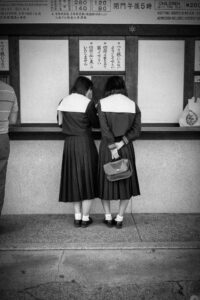 Harry De Zitter’s Schoolgirls Buying Train Tickets, Zushi, Japan (1986)[/caption]
Harry De Zitter’s Schoolgirls Buying Train Tickets, Zushi, Japan (1986)[/caption]
[caption id="attachment_70901" align="aligncenter" width="300"]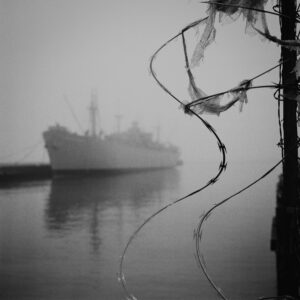 WWII Liberty Ship in Fog, Embarcadero, San Francisco (1996)[/caption]
WWII Liberty Ship in Fog, Embarcadero, San Francisco (1996)[/caption]
The post Meet Naples Visionary Photographer Harry De Zitter appeared first on Gulfshore Life.
]]> In April, photographer Harry De Zitter found himself standing in the middle of a road in his native South Africa. He was talking with a friend in the Karoo, an arid region covered with low scrub brushes. The open, umber-colored plains surrounding them reached into infinite stretches as another man approached. Harry’s focus drifted to the newcomer’s fraying boots and the dusty, shattered asphalt beneath. He couldn’t help but take a shot. The resulting black-and-white photograph is so sparse and candid that it becomes affectingly intimate.
Harry, who spends most of the year in Naples, has a decades-long career as an advertising photographer. He’s a titan in the industry, globetrotting to cover splashy campaigns for dozens of top-tier clients, ranging from Mercedes-Benz and Stella Artois to Wrangler and IBM. He’s photographed Paul McCartney and Bill Gates, run studios in New York City and London, and published work in Elle Italia and Conde Nast Traveler.
[caption id="attachment_70895" align="aligncenter" width="300"]
In April, photographer Harry De Zitter found himself standing in the middle of a road in his native South Africa. He was talking with a friend in the Karoo, an arid region covered with low scrub brushes. The open, umber-colored plains surrounding them reached into infinite stretches as another man approached. Harry’s focus drifted to the newcomer’s fraying boots and the dusty, shattered asphalt beneath. He couldn’t help but take a shot. The resulting black-and-white photograph is so sparse and candid that it becomes affectingly intimate.
Harry, who spends most of the year in Naples, has a decades-long career as an advertising photographer. He’s a titan in the industry, globetrotting to cover splashy campaigns for dozens of top-tier clients, ranging from Mercedes-Benz and Stella Artois to Wrangler and IBM. He’s photographed Paul McCartney and Bill Gates, run studios in New York City and London, and published work in Elle Italia and Conde Nast Traveler.
[caption id="attachment_70895" align="aligncenter" width="300"] For his personal work, the advertising photographer titan shoots in grayscale. “Black and white gets at the reality of the place,” he says.[/caption]
But, when it comes to his personal projects, Harry favors story-driven compositions in black and white. Images like the one he captured on that desert road this past spring, Worker with Well-Worn Boots, elevate the aloof or mundane into a haunting human treatise and distinguish the photographer as an artist. “My viewfinder is my window to the world,” he says.
[caption id="attachment_70894" align="alignleft" width="300"]
For his personal work, the advertising photographer titan shoots in grayscale. “Black and white gets at the reality of the place,” he says.[/caption]
But, when it comes to his personal projects, Harry favors story-driven compositions in black and white. Images like the one he captured on that desert road this past spring, Worker with Well-Worn Boots, elevate the aloof or mundane into a haunting human treatise and distinguish the photographer as an artist. “My viewfinder is my window to the world,” he says.
[caption id="attachment_70894" align="alignleft" width="300"] Family Waiting at Bus Stop, Natal, South Africa (1988)[/caption]
[caption id="attachment_70893" align="alignright" width="300"]
Family Waiting at Bus Stop, Natal, South Africa (1988)[/caption]
[caption id="attachment_70893" align="alignright" width="300"] Farm Landscape, Overberg, South Africa (2017)[/caption]
Harry estimates that 90 percent of his work as an advertising photographer has been in color; his black-and-white photographs are all his—a fascination that’s stayed with him since college. He recalls the campus’ dark room and watching his first black-and-white shot come into focus under dim red light. “I was smitten,” he says. “It was magic.”
As his career in advertising photography coalesced, Harry kept returning to his monochromatic passions. It has cojones (nerve), he says of the grayscale palette. “It has texture; it has soul,” he adds, leaning forward in a burst of animation. “It reminds me of hearing a record producer talk about digital recordings, that they’re sometimes too clean. You need grit and noise.”
The absence of color, combined with Harry’s uncanny observational acumen, has yielded hundreds of black-and-white photos documenting people, places and possessions across the planet. In monochrome, Harry’s work is less encumbered by visual distractions, making his images sharper, starker. “Black and white gets at the reality of the place,” he says.
[caption id="attachment_70892" align="alignleft" width="300"]
Farm Landscape, Overberg, South Africa (2017)[/caption]
Harry estimates that 90 percent of his work as an advertising photographer has been in color; his black-and-white photographs are all his—a fascination that’s stayed with him since college. He recalls the campus’ dark room and watching his first black-and-white shot come into focus under dim red light. “I was smitten,” he says. “It was magic.”
As his career in advertising photography coalesced, Harry kept returning to his monochromatic passions. It has cojones (nerve), he says of the grayscale palette. “It has texture; it has soul,” he adds, leaning forward in a burst of animation. “It reminds me of hearing a record producer talk about digital recordings, that they’re sometimes too clean. You need grit and noise.”
The absence of color, combined with Harry’s uncanny observational acumen, has yielded hundreds of black-and-white photos documenting people, places and possessions across the planet. In monochrome, Harry’s work is less encumbered by visual distractions, making his images sharper, starker. “Black and white gets at the reality of the place,” he says.
[caption id="attachment_70892" align="alignleft" width="300"] Worker with Well-Worn Boots, Middelpos, Karoo, South Africa (2024)[/caption]
Look at his photographs like Chrysler Building and Empire State Building. The images capture New York City’s famed landmarks, not as chipper postcard scenes but almost ominously in their achromatic states—a reminder that there’s more grit than glamour in the city’s grind. The same pathos is palpable in his monochrome landscapes. In The Everglades, part of his Chasing Clouds series, the inky undersides of thunderheads swell forebodingly over the swamp’s horizon. “That image wouldn’t have the same power in color,” he says definitively.
Grayscale photography has a narrative quality, too, Harry says, particularly with human subjects. In the 2019 Grandmother Shopping with her Granddaughter at Thursday Market, Harry captures a tender moment amid the streets of Bassano del Grappa, a town in northern Italy. The double portrait narrows in on the pair’s interlocked arms and hands, cropping out their faces entirely. The generational gap is evident through their wardrobe—the granddaughter wears a baggy Adidas shirt; the grandmother, a tidy ensemble with a structured handbag—and the warmth is palpable with how they lean on each other. “I was moved by the granddaughter’s tenderness for her grandmother,” Harry says. “The act of her affectionately holding her grandmother’s arm, whereas most teenagers would be too embarrassed to be seen with their grandparent, [struck me].”
[caption id="attachment_70897" align="alignleft" width="300"]
Worker with Well-Worn Boots, Middelpos, Karoo, South Africa (2024)[/caption]
Look at his photographs like Chrysler Building and Empire State Building. The images capture New York City’s famed landmarks, not as chipper postcard scenes but almost ominously in their achromatic states—a reminder that there’s more grit than glamour in the city’s grind. The same pathos is palpable in his monochrome landscapes. In The Everglades, part of his Chasing Clouds series, the inky undersides of thunderheads swell forebodingly over the swamp’s horizon. “That image wouldn’t have the same power in color,” he says definitively.
Grayscale photography has a narrative quality, too, Harry says, particularly with human subjects. In the 2019 Grandmother Shopping with her Granddaughter at Thursday Market, Harry captures a tender moment amid the streets of Bassano del Grappa, a town in northern Italy. The double portrait narrows in on the pair’s interlocked arms and hands, cropping out their faces entirely. The generational gap is evident through their wardrobe—the granddaughter wears a baggy Adidas shirt; the grandmother, a tidy ensemble with a structured handbag—and the warmth is palpable with how they lean on each other. “I was moved by the granddaughter’s tenderness for her grandmother,” Harry says. “The act of her affectionately holding her grandmother’s arm, whereas most teenagers would be too embarrassed to be seen with their grandparent, [struck me].”
[caption id="attachment_70897" align="alignleft" width="300"] Grandmother Shopping with her Granddaughter at Thursday Market, Bassano del Grappa, Italy (2019)[/caption]
As they talked, the nonna told him that Lino Manfrotto, the founder of renowned photography and videography equipment company Manfrotto, had been her wedding photographer. She didn’t know Harry had been an ambassador and product tester for the brand for years, a partnership that continues to this day.
Born in Belgium, Harry and his family moved to South Africa’s Eastern Cape when he was 9 months old. At 18, he enrolled in the Port Elizabeth Art School (now part of Nelson Mandela University) and soon found work as an assistant in his professor’s son’s darkroom. “I’ve had to be very versatile,” Harry says. “In the United States and Europe, photographers specialize because there are so many people working in places like New York, London, Paris. But in South Africa, you had to do it all—cars, fashion, still life.”
Much of Harry’s South African photography serves as a documentation of his home as he knows it: interior shots of his brother’s workshop, portraits of longtime friends and prominent creatives, candid shots of locals in various parts of the country.
[caption id="attachment_70896" align="alignleft" width="300"]
Grandmother Shopping with her Granddaughter at Thursday Market, Bassano del Grappa, Italy (2019)[/caption]
As they talked, the nonna told him that Lino Manfrotto, the founder of renowned photography and videography equipment company Manfrotto, had been her wedding photographer. She didn’t know Harry had been an ambassador and product tester for the brand for years, a partnership that continues to this day.
Born in Belgium, Harry and his family moved to South Africa’s Eastern Cape when he was 9 months old. At 18, he enrolled in the Port Elizabeth Art School (now part of Nelson Mandela University) and soon found work as an assistant in his professor’s son’s darkroom. “I’ve had to be very versatile,” Harry says. “In the United States and Europe, photographers specialize because there are so many people working in places like New York, London, Paris. But in South Africa, you had to do it all—cars, fashion, still life.”
Much of Harry’s South African photography serves as a documentation of his home as he knows it: interior shots of his brother’s workshop, portraits of longtime friends and prominent creatives, candid shots of locals in various parts of the country.
[caption id="attachment_70896" align="alignleft" width="300"] Chrysler Building, New York City, New York (1995)[/caption]
Amid these familial and fraternal frames are photographs like Family Waiting at Bus Stop. The arresting image, shot for Manfrotto, captures an African family of nine deep in the Zulu nation (one of South Africa’s native populations). The subjects seem to scrutinize the man behind the lens—the younger family members stare back, unabashed but slightly defensive, except for two: an infant and a young boy in a dark V-neck sweater. The boy looks vulnerable and forlorn, having resigned himself to this stranger taking his photo. The feeling of surrender in his eyes betrays his siblings’ stoicism. Harry felt the tension when he snapped the shot, but rather than shy from discomfort, he leaned into the honesty of the moment.
After all, his goal is to capture the raw beauty and truth of life. “There’s something about the strength of black and white,” Harry says. “I’ve always had a little thing on my shoulder—I don’t want to call it an angel, because I’m not religious—telling me to shoot in black and white.”
[caption id="attachment_70900" align="aligncenter" width="200"]
Chrysler Building, New York City, New York (1995)[/caption]
Amid these familial and fraternal frames are photographs like Family Waiting at Bus Stop. The arresting image, shot for Manfrotto, captures an African family of nine deep in the Zulu nation (one of South Africa’s native populations). The subjects seem to scrutinize the man behind the lens—the younger family members stare back, unabashed but slightly defensive, except for two: an infant and a young boy in a dark V-neck sweater. The boy looks vulnerable and forlorn, having resigned himself to this stranger taking his photo. The feeling of surrender in his eyes betrays his siblings’ stoicism. Harry felt the tension when he snapped the shot, but rather than shy from discomfort, he leaned into the honesty of the moment.
After all, his goal is to capture the raw beauty and truth of life. “There’s something about the strength of black and white,” Harry says. “I’ve always had a little thing on my shoulder—I don’t want to call it an angel, because I’m not religious—telling me to shoot in black and white.”
[caption id="attachment_70900" align="aligncenter" width="200"] Harry De Zitter’s Schoolgirls Buying Train Tickets, Zushi, Japan (1986)[/caption]
[caption id="attachment_70901" align="aligncenter" width="300"]
Harry De Zitter’s Schoolgirls Buying Train Tickets, Zushi, Japan (1986)[/caption]
[caption id="attachment_70901" align="aligncenter" width="300"] WWII Liberty Ship in Fog, Embarcadero, San Francisco (1996)[/caption]
WWII Liberty Ship in Fog, Embarcadero, San Francisco (1996)[/caption]The post Meet Naples Visionary Photographer Harry De Zitter appeared first on Gulfshore Life.
]]>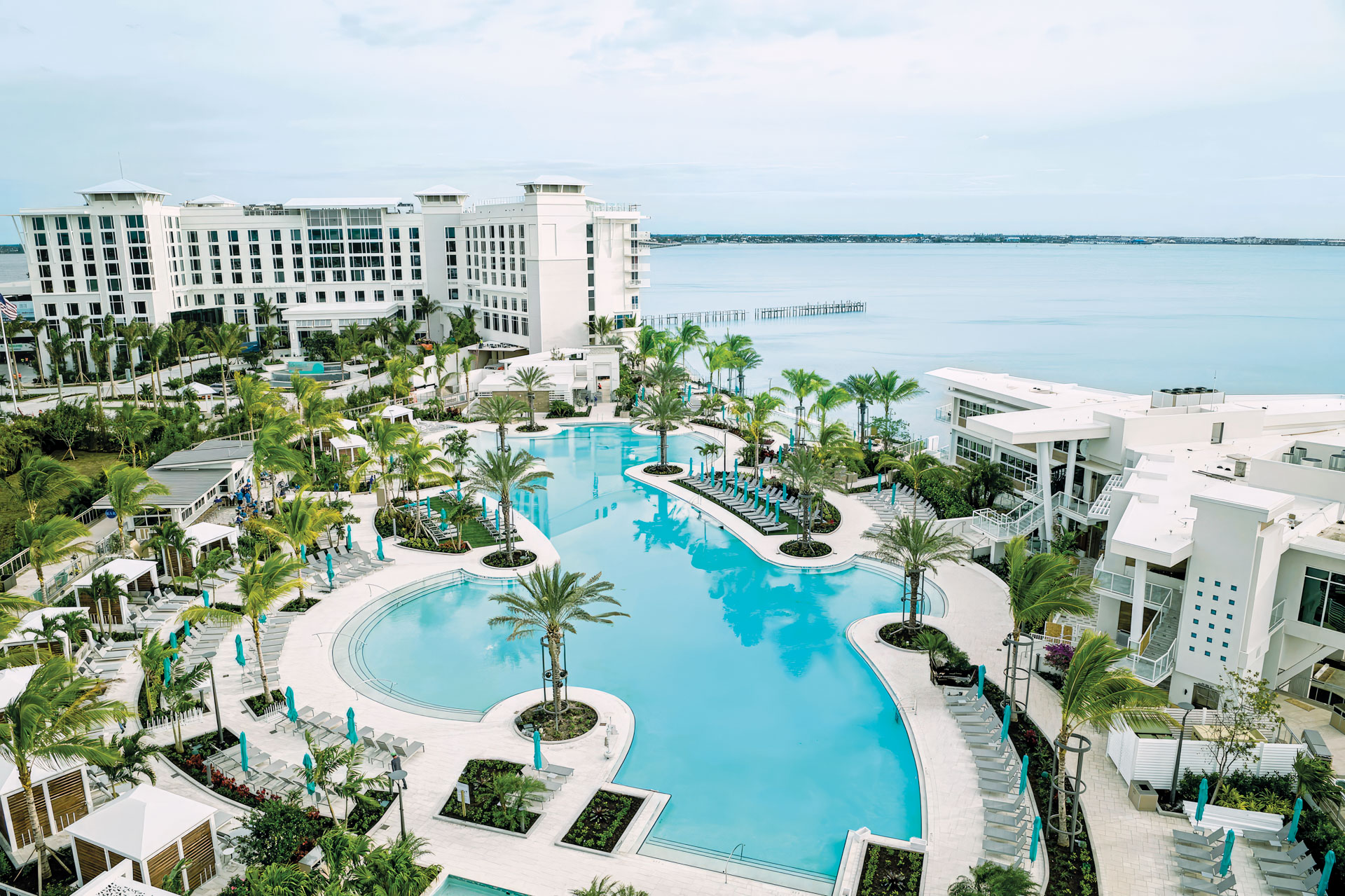
Florida’s nickname, the Sunshine State, may pay tribute to our abundant bluebird days, but I prefer the moments just before dark, when the light bends and melts over the coast in a fiery gradient of oranges, reds and pinks. Even after seeing some of the most jaw-dropping places in the world over the past year as a travel writer, Southwest Florida is still unrivaled in her beauty at sunset. Now, I’ve finally found the best seat to catch the fiery show: Sunseeker Resort Charlotte Harbor. Tethered to the Peace River in Punta Gorda, Sunseeker opened its doors in December, after nearly six years of anticipation.
Budget airline Allegiant spent more than $650 million on this plush, 22-acre resort that’s equally attractive for local staycationers and global travelers. A stay in one of the 785 rooms—many of which are suites with bedrooms, full kitchens and private balconies, with water views—unlocks a host of exclusive amenities. Topping the list are the rolling fairways at the nearby Aileron Golf Club—an 18-hole course designed by Kipp Schulties Golf Design, the architects behind more than 50 courses in the state, including The Legends in Fort Myers and Naples’ Vanderbilt Country Club.
The 20 onsite dining and drinking establishments (also open to the public) likely mean those suite kitchens will go largely unused (though they’ll be good for storing snacks and drinks for nightcaps). Split colossal tiger prawns and a monstrous tomahawk at Maury’s steakhouse, sip more than 100 tequilas at coastal Mexican Blue Lime, or book a table for farm-to-table Italian at Stretto. I particularly love the Harbor Yards Food Hall, which has vendors devoted to perfecting a single specialty, from gelato at Charlotte Parlor to charcuterie boards at Chartisan. (Don’t worry, you can work off all the overindulging later at the Technogym-stocked fitness center, where walls of glass grant a 180-degree view of Charlotte Harbor.)
Still, the main focus of your visit is on the views across the waterfront, seen from the resort’s bounty of westward-facing amenities. On the first day of my staycation, lounging in the ground-level pool with a cocktail in hand, I watch as a brilliant sunset casts pastel streaks across the sky. Eight stories above, other guests gather around the adults-only rooftop pool, where the view is even more glorious, sweeping across the glassy Charlotte Harbor toward the endless horizon beyond.
Around here, there’s really no bad seat in the house when the sun takes its final bow; wherever you are on the property, it’s sure to be a stellar performance.
The post Charlotte Harbor’s New Ultraluxe Staycation is for SWFL Sunset Lovers appeared first on Gulfshore Life.
]]>
Florida’s nickname, the Sunshine State, may pay tribute to our abundant bluebird days, but I prefer the moments just before dark, when the light bends and melts over the coast in a fiery gradient of oranges, reds and pinks. Even after seeing some of the most jaw-dropping places in the world over the past year as a travel writer, Southwest Florida is still unrivaled in her beauty at sunset. Now, I’ve finally found the best seat to catch the fiery show: Sunseeker Resort Charlotte Harbor. Tethered to the Peace River in Punta Gorda, Sunseeker opened its doors in December, after nearly six years of anticipation.
Budget airline Allegiant spent more than $650 million on this plush, 22-acre resort that’s equally attractive for local staycationers and global travelers. A stay in one of the 785 rooms—many of which are suites with bedrooms, full kitchens and private balconies, with water views—unlocks a host of exclusive amenities. Topping the list are the rolling fairways at the nearby Aileron Golf Club—an 18-hole course designed by Kipp Schulties Golf Design, the architects behind more than 50 courses in the state, including The Legends in Fort Myers and Naples’ Vanderbilt Country Club.
The 20 onsite dining and drinking establishments (also open to the public) likely mean those suite kitchens will go largely unused (though they’ll be good for storing snacks and drinks for nightcaps). Split colossal tiger prawns and a monstrous tomahawk at Maury’s steakhouse, sip more than 100 tequilas at coastal Mexican Blue Lime, or book a table for farm-to-table Italian at Stretto. I particularly love the Harbor Yards Food Hall, which has vendors devoted to perfecting a single specialty, from gelato at Charlotte Parlor to charcuterie boards at Chartisan. (Don’t worry, you can work off all the overindulging later at the Technogym-stocked fitness center, where walls of glass grant a 180-degree view of Charlotte Harbor.)
Still, the main focus of your visit is on the views across the waterfront, seen from the resort’s bounty of westward-facing amenities. On the first day of my staycation, lounging in the ground-level pool with a cocktail in hand, I watch as a brilliant sunset casts pastel streaks across the sky. Eight stories above, other guests gather around the adults-only rooftop pool, where the view is even more glorious, sweeping across the glassy Charlotte Harbor toward the endless horizon beyond.
Around here, there’s really no bad seat in the house when the sun takes its final bow; wherever you are on the property, it’s sure to be a stellar performance.
The post Charlotte Harbor’s New Ultraluxe Staycation is for SWFL Sunset Lovers appeared first on Gulfshore Life.
]]>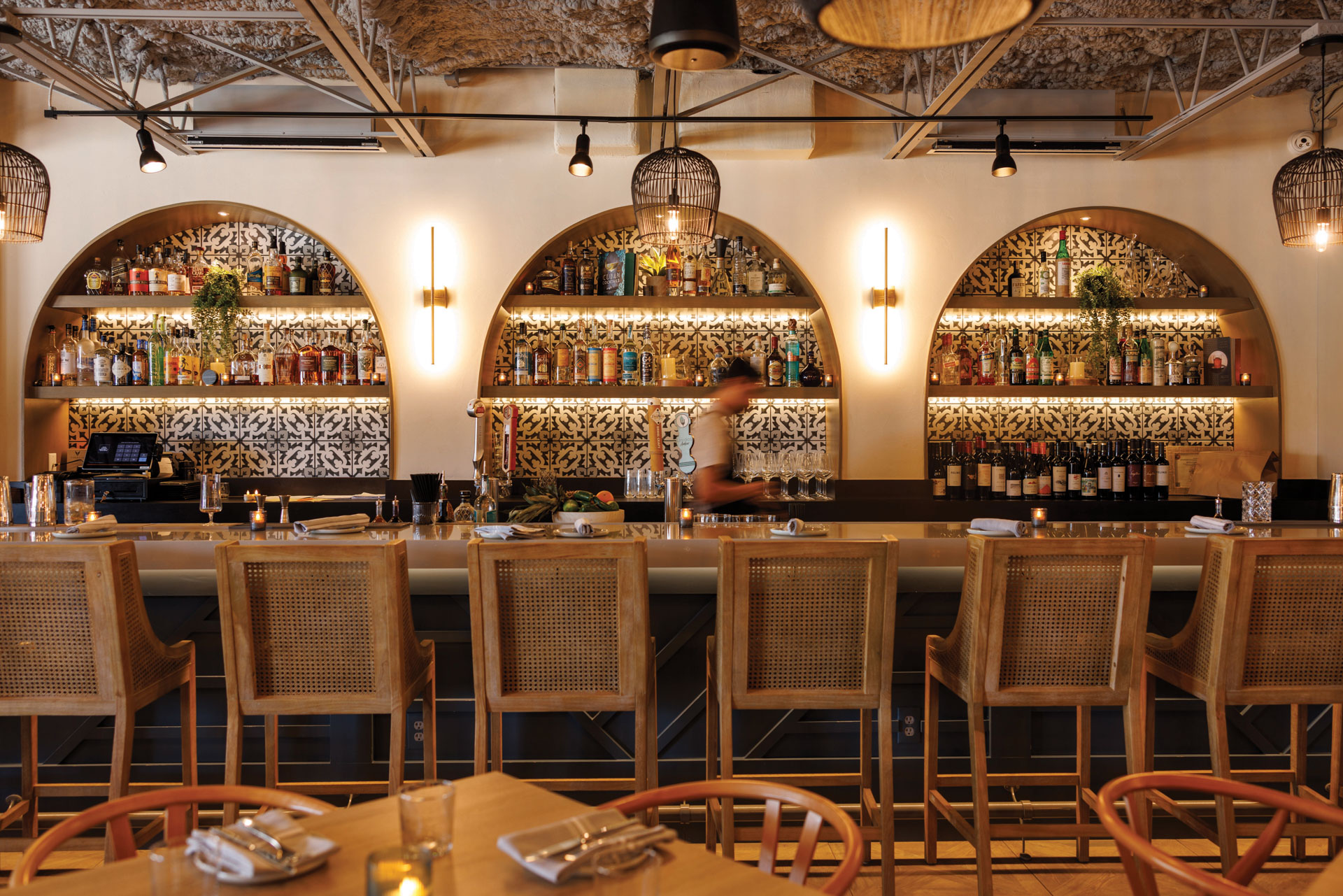
Everyone is a regular at Unidos. Easy interactions punctuate visits to this Latin fusion restaurant, where the hospitality channels the attention of notoriously generous Hispanic grandmothers.
Soon after the restaurant opened in January, a friend and I sidled into one of the peony pink banquettes for supper. The dining room was already alive with the buzz of cocktail hour, and the late afternoon sun blazed through the wall of windows into the chic, midcentury-meets-coastal hacienda space—and directly into my eyes. Within seconds of clocking my discomfort, the hostess pressed a button to lower the shades (soon after, she raised them again, as if on cue, for sunset).
With an emphasis on remixing Latin American flavors and traditions with global culinary cornerstones (French, Italian, Asian, Spanish), the Naples Design District restaurant introduces something new to Southwest Florida. While hotspots like Bicyclette Cookshop, Warren and Le Colonial have claimed the media spotlight for the past few months, Unidos—from the trio behind Chicago-based restaurant Unidad—started with a quiet rollout, flying relatively under the radar.
For our team, the vibrant Ninth Street South newcomer is the undisputed standout of the year. Our Colombian-American editor-in-chief claims it was love at first bite when she had Unidos’ delightfully golden, crispy empanadas (“Who knew the original could be improved?” she says). The presentation and vigorous flavors resonated with our former food editor Andrew Atkins, too, who ranked the pork shank tacos in the realm of the divine. As for me, I was hooked by the service—all the attention of white-glove hospitality, with the relaxed feel of being with friends. The elements all add up to create a place that seems like it’s been there forever.
Around the open kitchen, barstools tempt guests to belly up for a front-row seat to the action. From our nearby perch, we can see executive chef Melina Martinez putting the finishing touches on our order of crispy yuca fries, a staple on many South American dinner tables. The 30-year-old, Mexican-born chef started as a dishwasher at Unidad when she was a teenager. Melina worked her way up the ranks until landing the lead role at Unidos. “We knew we had a person in Chicago who’s young, aggressive and a superstar in the kitchen,” says Carlos Angel, who is Colombian and owns Unidos with husband-wife duo Sal and Jaime Muñoz. “[Melina] was the first to understand [our idea of] fusion.”
Melina, Carlos and Sal collaborate on the menus, playing with cooking traditions and flavors from gustatorily rich Latin American countries, including their native lands, as well as Argentina, Cuba, Brazil and Peru. Three-hour testing sessions are standard as the trio reinterprets heritage-driven recipes through the lens of popular global cuisines—and vice versa. Italian risotto gets tropicalized with passion fruit sauce-enveloped salmon, and in a riff on Asian crispy rice, Peruvian ceviche is perched atop croquettes of fried rice, served with Argentine chimichurri.
Every recipe harkens to a place—whether it be the team’s childhood family tables or the slate of restaurants they’ve scouted in the Americas in search of inspiration. The elote fritters—Unidos’ smashed, tempura-covered version of Mexican street corn with cult-favorite Japanese Kewpie mayonnaise—embody the spirit of teamwork, experimentation and underlying pride-of-place that anchors the restaurant. “It takes me back to my childhood,” says Sal, who lived in his family’s native Mexico for a couple of years in his youth.
Like the kitchen, the bar is central to the design and open to diners. High-spirited bartenders mix Latin libations like the pisco sour and caipirinha, as well as spins on classic cocktails, like an old-fashioned with a blended mezcal and rye base. Tropical sippers, like the blueberry-jam mojito mocktail I enjoyed, offer something equally intriguing for non-imbibers.
A festive atmosphere permeates the space as pop favorites remixed with Latin beats (think: Coldplay songs by a cumbia band) play in the background. At the heart of the operation is the flaming Santa Maria grill (similar to an Argentine parrilla but more versatile), fueled by high-heat South American Quebracho hardwood that imparts the intensely smoky, earthy flavor of Argentine barbecue. This beast of a machine is responsible for the envy-inducing pork tacos—a whole slow-cooked shank with meat that slides off the bone, served in a mini cast-iron skillet with greens and blue corn tortillas. Colombian chef Boris Alverez mans the grill, using two cranks to raise and lower the grates for the perfect level of caramelization on Argentinian vacío de novillo (flap steak), Brazilian picanha (juicy top sirloin) and cauliflower steak with passion fruit-coconut sauce.
[caption id="attachment_68676" align="aligncenter" width="683"]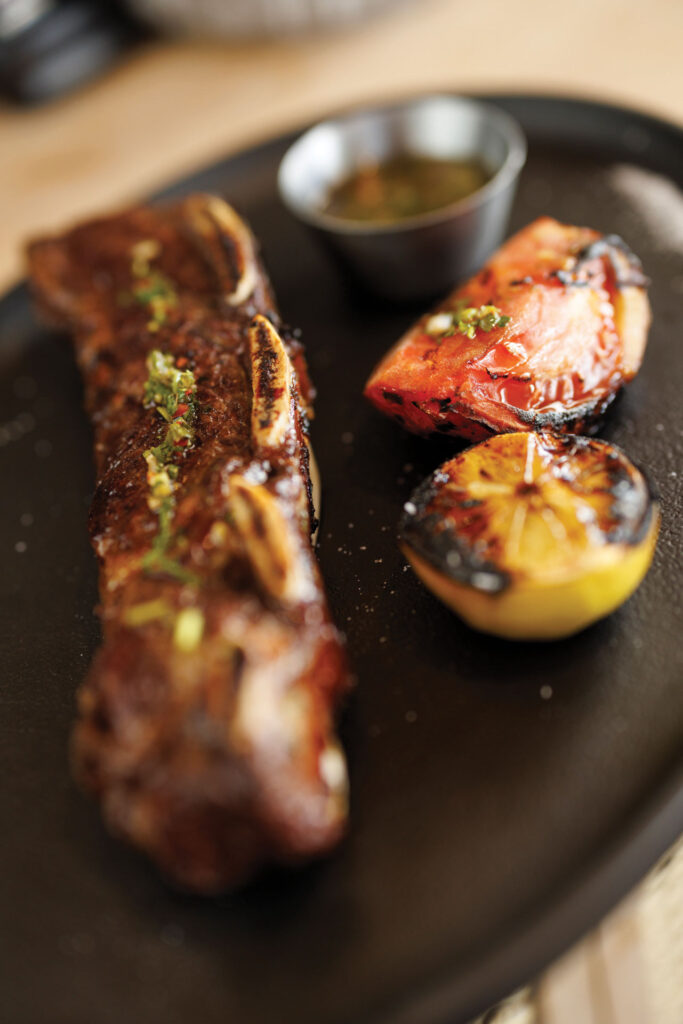 Carlos Angel, Sal Muñoz and Jaime Muñoz opened Unidos in January. Our editors were struck by the under-the-radar restaurant’s welcoming atmosphere, intuitive service and vibrant, Latin American flavors. (Photo By Brian Tietz)[/caption]
Carlos Angel, Sal Muñoz and Jaime Muñoz opened Unidos in January. Our editors were struck by the under-the-radar restaurant’s welcoming atmosphere, intuitive service and vibrant, Latin American flavors. (Photo By Brian Tietz)[/caption]
Housed in a former Starbucks, Unidos stylishly blends into the setting with its gray wraparound metal overhang and black-framed windows. Inside, Jaime worked on the design, mixing rattan pendant lights with pink diner-style booths and rock-cage benches for a Latin midcentury-meets-coastal aesthetic. Ornate tiles, imported from Colombia, add to the sense of place, while the exposed ceilings and quartz bar keep the look decidedly contemporary.
Warm, spirited hospitality is a trademark of Latin American culture, and in this area, Unidos follows its muse to the T. Servers and guests quickly become friends, and Sal and Carlos often stroll the dining room, bussing tables, recommending dishes or offering special pours of late harvest Malbec. The restaurant embodies its name, Unidos, a.k.a. Together—everyone feels part of one, knitted, palate-expanding experience.
As we leave the restaurant, I’m sated and warm—like how I feel leaving a family member’s table. Many restaurants strive to create an ambiance that feels like home; Unidos perfects the vibe.
The post Raising the Bar on Latin Food in Naples appeared first on Gulfshore Life.
]]>
Everyone is a regular at Unidos. Easy interactions punctuate visits to this Latin fusion restaurant, where the hospitality channels the attention of notoriously generous Hispanic grandmothers.
Soon after the restaurant opened in January, a friend and I sidled into one of the peony pink banquettes for supper. The dining room was already alive with the buzz of cocktail hour, and the late afternoon sun blazed through the wall of windows into the chic, midcentury-meets-coastal hacienda space—and directly into my eyes. Within seconds of clocking my discomfort, the hostess pressed a button to lower the shades (soon after, she raised them again, as if on cue, for sunset).
With an emphasis on remixing Latin American flavors and traditions with global culinary cornerstones (French, Italian, Asian, Spanish), the Naples Design District restaurant introduces something new to Southwest Florida. While hotspots like Bicyclette Cookshop, Warren and Le Colonial have claimed the media spotlight for the past few months, Unidos—from the trio behind Chicago-based restaurant Unidad—started with a quiet rollout, flying relatively under the radar.
For our team, the vibrant Ninth Street South newcomer is the undisputed standout of the year. Our Colombian-American editor-in-chief claims it was love at first bite when she had Unidos’ delightfully golden, crispy empanadas (“Who knew the original could be improved?” she says). The presentation and vigorous flavors resonated with our former food editor Andrew Atkins, too, who ranked the pork shank tacos in the realm of the divine. As for me, I was hooked by the service—all the attention of white-glove hospitality, with the relaxed feel of being with friends. The elements all add up to create a place that seems like it’s been there forever.
Around the open kitchen, barstools tempt guests to belly up for a front-row seat to the action. From our nearby perch, we can see executive chef Melina Martinez putting the finishing touches on our order of crispy yuca fries, a staple on many South American dinner tables. The 30-year-old, Mexican-born chef started as a dishwasher at Unidad when she was a teenager. Melina worked her way up the ranks until landing the lead role at Unidos. “We knew we had a person in Chicago who’s young, aggressive and a superstar in the kitchen,” says Carlos Angel, who is Colombian and owns Unidos with husband-wife duo Sal and Jaime Muñoz. “[Melina] was the first to understand [our idea of] fusion.”
Melina, Carlos and Sal collaborate on the menus, playing with cooking traditions and flavors from gustatorily rich Latin American countries, including their native lands, as well as Argentina, Cuba, Brazil and Peru. Three-hour testing sessions are standard as the trio reinterprets heritage-driven recipes through the lens of popular global cuisines—and vice versa. Italian risotto gets tropicalized with passion fruit sauce-enveloped salmon, and in a riff on Asian crispy rice, Peruvian ceviche is perched atop croquettes of fried rice, served with Argentine chimichurri.
Every recipe harkens to a place—whether it be the team’s childhood family tables or the slate of restaurants they’ve scouted in the Americas in search of inspiration. The elote fritters—Unidos’ smashed, tempura-covered version of Mexican street corn with cult-favorite Japanese Kewpie mayonnaise—embody the spirit of teamwork, experimentation and underlying pride-of-place that anchors the restaurant. “It takes me back to my childhood,” says Sal, who lived in his family’s native Mexico for a couple of years in his youth.
Like the kitchen, the bar is central to the design and open to diners. High-spirited bartenders mix Latin libations like the pisco sour and caipirinha, as well as spins on classic cocktails, like an old-fashioned with a blended mezcal and rye base. Tropical sippers, like the blueberry-jam mojito mocktail I enjoyed, offer something equally intriguing for non-imbibers.
A festive atmosphere permeates the space as pop favorites remixed with Latin beats (think: Coldplay songs by a cumbia band) play in the background. At the heart of the operation is the flaming Santa Maria grill (similar to an Argentine parrilla but more versatile), fueled by high-heat South American Quebracho hardwood that imparts the intensely smoky, earthy flavor of Argentine barbecue. This beast of a machine is responsible for the envy-inducing pork tacos—a whole slow-cooked shank with meat that slides off the bone, served in a mini cast-iron skillet with greens and blue corn tortillas. Colombian chef Boris Alverez mans the grill, using two cranks to raise and lower the grates for the perfect level of caramelization on Argentinian vacío de novillo (flap steak), Brazilian picanha (juicy top sirloin) and cauliflower steak with passion fruit-coconut sauce.
[caption id="attachment_68676" align="aligncenter" width="683"] Carlos Angel, Sal Muñoz and Jaime Muñoz opened Unidos in January. Our editors were struck by the under-the-radar restaurant’s welcoming atmosphere, intuitive service and vibrant, Latin American flavors. (Photo By Brian Tietz)[/caption]
Carlos Angel, Sal Muñoz and Jaime Muñoz opened Unidos in January. Our editors were struck by the under-the-radar restaurant’s welcoming atmosphere, intuitive service and vibrant, Latin American flavors. (Photo By Brian Tietz)[/caption]
Housed in a former Starbucks, Unidos stylishly blends into the setting with its gray wraparound metal overhang and black-framed windows. Inside, Jaime worked on the design, mixing rattan pendant lights with pink diner-style booths and rock-cage benches for a Latin midcentury-meets-coastal aesthetic. Ornate tiles, imported from Colombia, add to the sense of place, while the exposed ceilings and quartz bar keep the look decidedly contemporary.
Warm, spirited hospitality is a trademark of Latin American culture, and in this area, Unidos follows its muse to the T. Servers and guests quickly become friends, and Sal and Carlos often stroll the dining room, bussing tables, recommending dishes or offering special pours of late harvest Malbec. The restaurant embodies its name, Unidos, a.k.a. Together—everyone feels part of one, knitted, palate-expanding experience.
As we leave the restaurant, I’m sated and warm—like how I feel leaving a family member’s table. Many restaurants strive to create an ambiance that feels like home; Unidos perfects the vibe.
The post Raising the Bar on Latin Food in Naples appeared first on Gulfshore Life.
]]>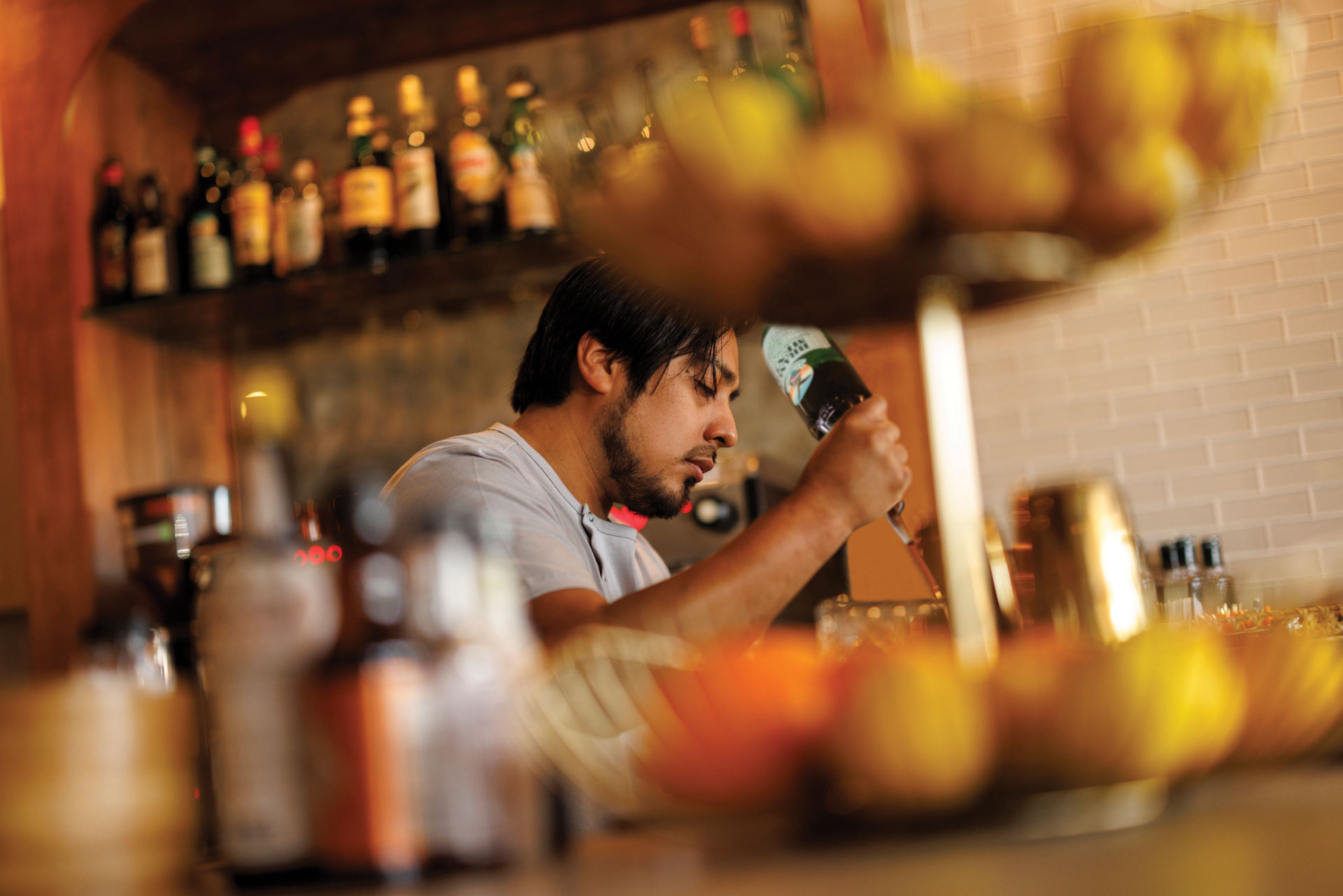
It doesn’t take much for bartender Edgar Sierra to know what kind of drink you’ll like when you slide up to the bar at Bicyclette Cookshop, the sleeper-hit restaurant that has taken Naples by storm since opening last fall. Small context clues, like your spirit of choice, lead to inspired delights: a gin-based sipper with a hibiscus tea reduction and citrus-curd puree (a far more complex take on flavored lemonade) or a spicy tequila espresso martini, like the one that earned him top place at this year’s Tromba Tequila Master of the Margarita competition.
The improvised libation was inspired by his Mexican grandmother’s café de olla (clay pot coffee). “It’s the same clay pot she uses for her chilis, beans—it’s multiuse,” he says. The porous surface retains the flavor, lending the coffee residual spice and earthiness. Edgar hopes to one day open a Mexican bar in Naples to showcase the true spectrum of his family’s native culture—the unsung spirits like fragrant raicilla and earthy bacanora; the blended diasporas that have influenced Mexico’s UNESCO-recognized culinary heritage; and the peoples’ familial-driven vivaciousness. “Hispanics have a big culture of partying, but there’s this beautiful side, where, although it’s a party, people really engage with one another,” he says.
While it’s been a few years since I put down my cocktail writer pen (I used to write a column for Southern Living about the American South’s then-exploding cocktail scene), I still appreciate a proper bar experience. In its most devout iteration, the industry draws highly creative, well-read, charismatic folks with a deep curiosity about the world around them. When I met Edgar, I saw all of this as he whipped up three- and eight-ingredient drinks with equal finesse, translated preferences into new creations, and expounded on spirits’ provenance with ease.
Starting his career in the kitchen at farm-to-table pioneer Blue Hill and the now-shuttered molecular gastronomy legend wd~50, Edgar learned to perfect the basics (his collection of culinary books is 200 deep and counting), honor tradition (he has deep reverence for the 20th-century classic and neoclassic cocktails) and to play adventurously with flavors. “Just because someone says something doesn’t work, doesn’t mean it won’t—we just haven’t found the way to make it work yet,” he says.
He moved to Naples in 2021 and worked at Rocco’s Tacos and Tequila Bar and District’s back-room speakeasy, Staff Only, before transitioning full-time to Bicyclette. The Vanderbilt Beach Road restaurant—with its innovative chef and kitchen—provides a perfect playground for professional bartenders like Edgar. By the end of his shift, the 31-year-old, New York transplant may have sous vide tequila with super spicy chile de árbol and smoky, chocolatey chile morita to rapidly infuse it for an árbol de tequila tincture; turned leftover citrus peels into a flavor-rich puree; and painted a chamoy puree rim onto a glass, which he then chills for a subtle tequila drink. The hardened condiment imparts delicate savoriness with each sip.
The term craft cocktail gets thrown around lightly these days, but here, it’s exemplified: drinks composed as stories. Edgar tells me about the New York icons like Pegu Club and Angel’s Share, where he began his self-education about 10 years ago, and his time working at ATLA (from the group behind The World’s 50 Best Restaurants standout Cosme). Places that, through osmosis, taught him the mechanics of a proper cocktail: nothing too sweet, nothing watered-down—you need a perfect balance of flavors and a nice, weighty mouthfeel. “It’s like a good wine, the flavors should dance in your mouth,” he says.
Edgar sees Southwest Florida’s bar culture as being at a tipping point, with modernist cocktailery taking root and possibilities abounding. He looks to places like Naples’ new Unidos Restaurant & Bar, with its singular focus on reinterpreting Latin American food and drink, and Chartreuse Craft Cocktail Lounge in Bonita Springs. “They have spirits you won’t find anywhere, like multiple varieties of Haitian rum,” he says.
Before closing down the bar, we toast to a night well spent. Edgar shakes up a gin martini with the addition of Yellow Chartreuse, St-Germain, orange blossom water and bitters. He splits the drink into three shot glasses and tops mine with a disc of candied citrus, brûléed and chilled on the spot. It’s the most sophisticated shooter I’ve seen. “The sugar crisp on the side mellows out all those strong flavors on your palette,” he says.
As I sip my uniquely smoky-meets-herbaceous mini martini, I’m reminded that you often don’t have to go further than your neighborhood bar to expand your palette and mind. And if your closest drinking den happens to be Bicyclette, go pull up a seat, ask for Edgar, and let him play.
The post Meet the Bartender Shaking Things Up in Naples appeared first on Gulfshore Life.
]]>
It doesn’t take much for bartender Edgar Sierra to know what kind of drink you’ll like when you slide up to the bar at Bicyclette Cookshop, the sleeper-hit restaurant that has taken Naples by storm since opening last fall. Small context clues, like your spirit of choice, lead to inspired delights: a gin-based sipper with a hibiscus tea reduction and citrus-curd puree (a far more complex take on flavored lemonade) or a spicy tequila espresso martini, like the one that earned him top place at this year’s Tromba Tequila Master of the Margarita competition.
The improvised libation was inspired by his Mexican grandmother’s café de olla (clay pot coffee). “It’s the same clay pot she uses for her chilis, beans—it’s multiuse,” he says. The porous surface retains the flavor, lending the coffee residual spice and earthiness. Edgar hopes to one day open a Mexican bar in Naples to showcase the true spectrum of his family’s native culture—the unsung spirits like fragrant raicilla and earthy bacanora; the blended diasporas that have influenced Mexico’s UNESCO-recognized culinary heritage; and the peoples’ familial-driven vivaciousness. “Hispanics have a big culture of partying, but there’s this beautiful side, where, although it’s a party, people really engage with one another,” he says.
While it’s been a few years since I put down my cocktail writer pen (I used to write a column for Southern Living about the American South’s then-exploding cocktail scene), I still appreciate a proper bar experience. In its most devout iteration, the industry draws highly creative, well-read, charismatic folks with a deep curiosity about the world around them. When I met Edgar, I saw all of this as he whipped up three- and eight-ingredient drinks with equal finesse, translated preferences into new creations, and expounded on spirits’ provenance with ease.
Starting his career in the kitchen at farm-to-table pioneer Blue Hill and the now-shuttered molecular gastronomy legend wd~50, Edgar learned to perfect the basics (his collection of culinary books is 200 deep and counting), honor tradition (he has deep reverence for the 20th-century classic and neoclassic cocktails) and to play adventurously with flavors. “Just because someone says something doesn’t work, doesn’t mean it won’t—we just haven’t found the way to make it work yet,” he says.
He moved to Naples in 2021 and worked at Rocco’s Tacos and Tequila Bar and District’s back-room speakeasy, Staff Only, before transitioning full-time to Bicyclette. The Vanderbilt Beach Road restaurant—with its innovative chef and kitchen—provides a perfect playground for professional bartenders like Edgar. By the end of his shift, the 31-year-old, New York transplant may have sous vide tequila with super spicy chile de árbol and smoky, chocolatey chile morita to rapidly infuse it for an árbol de tequila tincture; turned leftover citrus peels into a flavor-rich puree; and painted a chamoy puree rim onto a glass, which he then chills for a subtle tequila drink. The hardened condiment imparts delicate savoriness with each sip.
The term craft cocktail gets thrown around lightly these days, but here, it’s exemplified: drinks composed as stories. Edgar tells me about the New York icons like Pegu Club and Angel’s Share, where he began his self-education about 10 years ago, and his time working at ATLA (from the group behind The World’s 50 Best Restaurants standout Cosme). Places that, through osmosis, taught him the mechanics of a proper cocktail: nothing too sweet, nothing watered-down—you need a perfect balance of flavors and a nice, weighty mouthfeel. “It’s like a good wine, the flavors should dance in your mouth,” he says.
Edgar sees Southwest Florida’s bar culture as being at a tipping point, with modernist cocktailery taking root and possibilities abounding. He looks to places like Naples’ new Unidos Restaurant & Bar, with its singular focus on reinterpreting Latin American food and drink, and Chartreuse Craft Cocktail Lounge in Bonita Springs. “They have spirits you won’t find anywhere, like multiple varieties of Haitian rum,” he says.
Before closing down the bar, we toast to a night well spent. Edgar shakes up a gin martini with the addition of Yellow Chartreuse, St-Germain, orange blossom water and bitters. He splits the drink into three shot glasses and tops mine with a disc of candied citrus, brûléed and chilled on the spot. It’s the most sophisticated shooter I’ve seen. “The sugar crisp on the side mellows out all those strong flavors on your palette,” he says.
As I sip my uniquely smoky-meets-herbaceous mini martini, I’m reminded that you often don’t have to go further than your neighborhood bar to expand your palette and mind. And if your closest drinking den happens to be Bicyclette, go pull up a seat, ask for Edgar, and let him play.
The post Meet the Bartender Shaking Things Up in Naples appeared first on Gulfshore Life.
]]>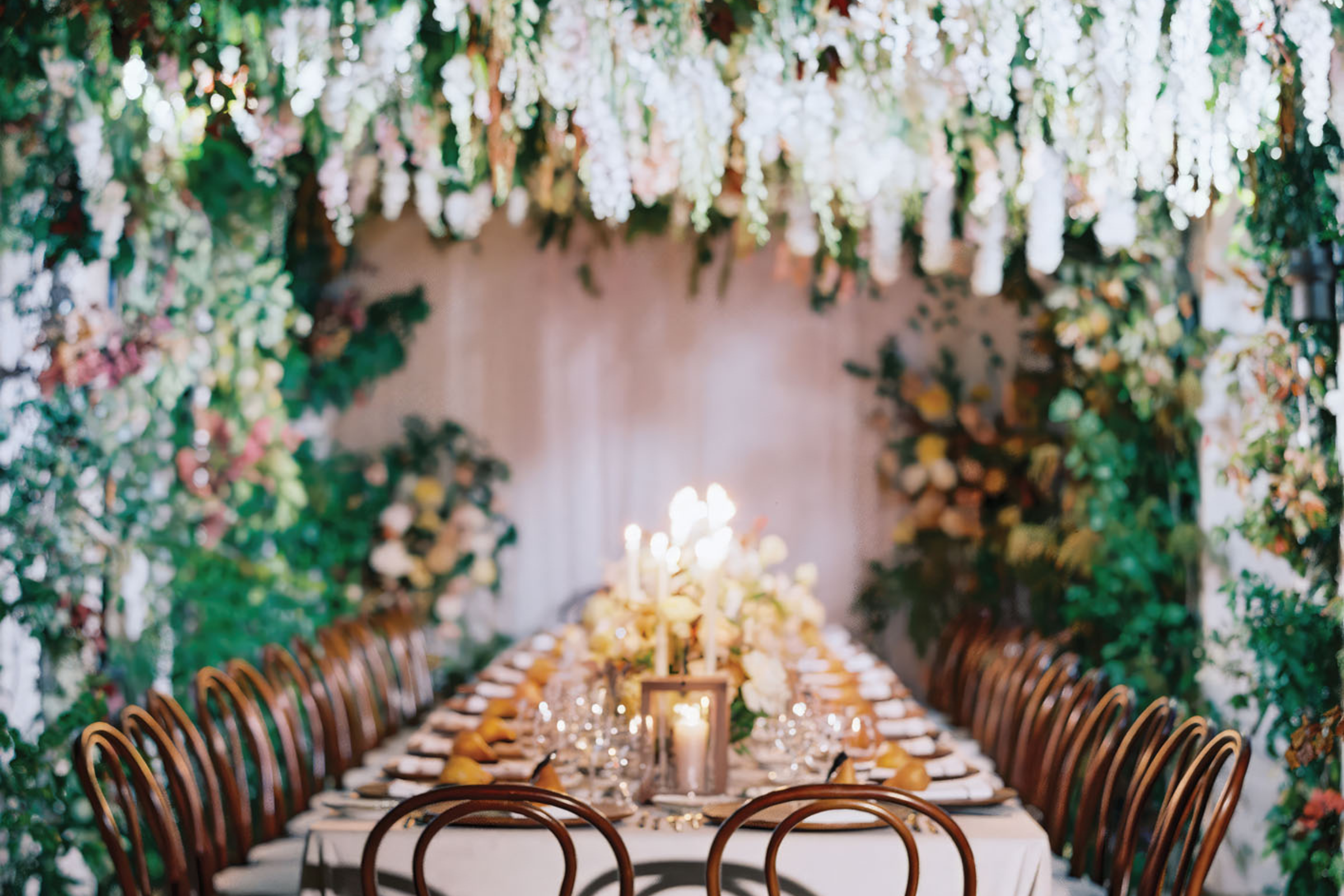
Sean and Melissa Stevenson, of Kaleidoscope Floral, may have spent most of their life in Naples, but their vision and palette are fully global. The florists are always tinkering online and researching rare plants, novel arrangements and innovations in floral design to push their genre forward.
You might not be able to precisely define the couple’s style (somewhat wild, somewhat sweet, somewhat strange and surreal), but you can be sure the Naples petal pushers will always deliver something wholly original. Perhaps that’s why gemologist and Gulfshore Life advisory board member Jennifer McCurry claims the duo as her go-to for special-occasion arrangements and botanical gifts.
Since 2015, the Stevensons’ arrangements have graced philanthropic gala tables, Port Royal entryways and small-business offices across the region, helping fuel a botanical revolution in Southwest Florida with dozens of boutique floral businesses popping up and the local penchant for wild blooms blooming. In their previous Fifth Avenue South and Third Street South storefronts, the couple used plants as the basis to promote a local-centric, earth-conscious lifestyle, with naturalist gifts, floral arranging classes and chic mixers (they are currently hunting for Kaleidoscope’s new home).
Sean forages his family’s 5-acre property in Naples around town and for native pieces of the land to integrate into artful arrangements. “If I’m driving down the road and see something growing off the side of highway or median, I will stop and—responsibly—snip it down,” Sean says. Unlike commercial florists who stock from clearing houses, the Stevensons work directly with small farmers and independent brokers to source sustainably grown, lesser-known blooms like the nodding, bell-shaped fritillaria, and rarer varieties of beloved English garden roses and dahlias. Unfettered blooms are shaped into impressionistic arrangements that emphasize the plants’ otherworldliness. Locally found morsels of palm tree seed pods, bromeliads and wild grasses give each composition a distinct sense of place.
After nearly a decade of delivering to tony neighborhoods, the Stevensons have developed a deep cachet of local intel. If your recipient is in the central Naples area, chances are Kaleidoscope Floral has supplied them with flowers. They could tell you that so-and-so loves feathery sugarbushes or that your new Southern mother-in-law swoons at the sight of buttercups—and tailor arrangements accordingly. “We have clients tell us about how they grew up with hydrangeas, and having them around the house takes them back to that place,” Sean says. “Flowers have this incredible power to transport you.”
The post This Naples Floral Design Studio Claims Top Billing For Our Resident Entertaining Expert appeared first on Gulfshore Life.
]]>
Sean and Melissa Stevenson, of Kaleidoscope Floral, may have spent most of their life in Naples, but their vision and palette are fully global. The florists are always tinkering online and researching rare plants, novel arrangements and innovations in floral design to push their genre forward.
You might not be able to precisely define the couple’s style (somewhat wild, somewhat sweet, somewhat strange and surreal), but you can be sure the Naples petal pushers will always deliver something wholly original. Perhaps that’s why gemologist and Gulfshore Life advisory board member Jennifer McCurry claims the duo as her go-to for special-occasion arrangements and botanical gifts.
Since 2015, the Stevensons’ arrangements have graced philanthropic gala tables, Port Royal entryways and small-business offices across the region, helping fuel a botanical revolution in Southwest Florida with dozens of boutique floral businesses popping up and the local penchant for wild blooms blooming. In their previous Fifth Avenue South and Third Street South storefronts, the couple used plants as the basis to promote a local-centric, earth-conscious lifestyle, with naturalist gifts, floral arranging classes and chic mixers (they are currently hunting for Kaleidoscope’s new home).
Sean forages his family’s 5-acre property in Naples around town and for native pieces of the land to integrate into artful arrangements. “If I’m driving down the road and see something growing off the side of highway or median, I will stop and—responsibly—snip it down,” Sean says. Unlike commercial florists who stock from clearing houses, the Stevensons work directly with small farmers and independent brokers to source sustainably grown, lesser-known blooms like the nodding, bell-shaped fritillaria, and rarer varieties of beloved English garden roses and dahlias. Unfettered blooms are shaped into impressionistic arrangements that emphasize the plants’ otherworldliness. Locally found morsels of palm tree seed pods, bromeliads and wild grasses give each composition a distinct sense of place.
After nearly a decade of delivering to tony neighborhoods, the Stevensons have developed a deep cachet of local intel. If your recipient is in the central Naples area, chances are Kaleidoscope Floral has supplied them with flowers. They could tell you that so-and-so loves feathery sugarbushes or that your new Southern mother-in-law swoons at the sight of buttercups—and tailor arrangements accordingly. “We have clients tell us about how they grew up with hydrangeas, and having them around the house takes them back to that place,” Sean says. “Flowers have this incredible power to transport you.”
The post This Naples Floral Design Studio Claims Top Billing For Our Resident Entertaining Expert appeared first on Gulfshore Life.
]]>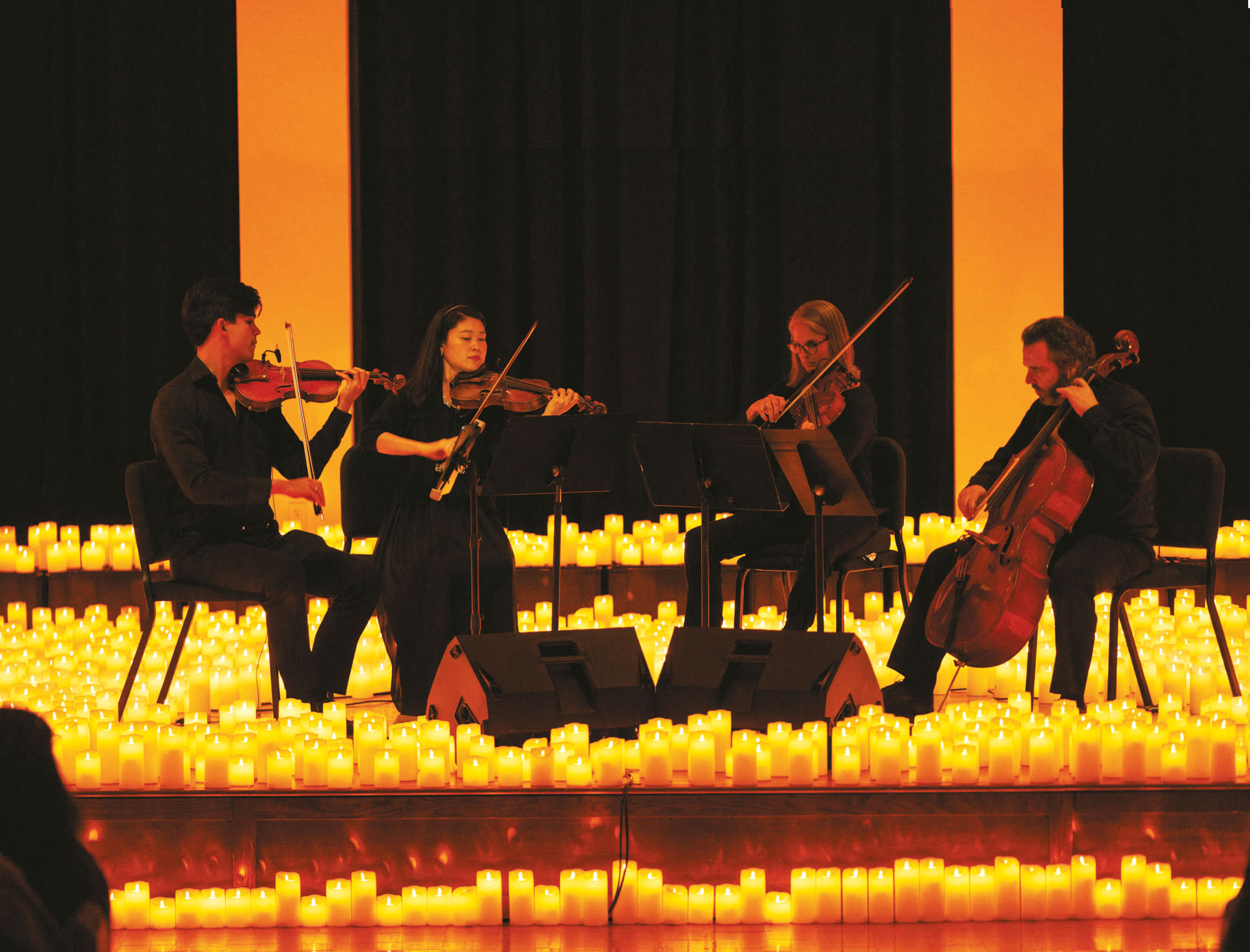
Classical melodies echo through my childhood memories of ballet class. I’ve always appreciated the genre, recalling how it sparked emotion and informed my movements. But now, with my slippers stashed as keepsakes, symphonic music isn’t regularly part of my playlists.
Increasing engagement is a crucial focus for orchestras today. How do they get the next generation tuned in? How do they draw audiences who dismiss the genre as elitist, people who hear the term ‘classical’ and picture debonair audiences, stoic musicians and grand concert halls? It takes the right hook to get new people in the door. For me and my friends, a night of classical takes on Taylor Swift’s discography was more than enough incentive.
This season, Gulf Coast Symphony partnered with international entertainment group Fever to host Candlelight Concerts—a traveling series with classical music and symphonic versions of contemporary hits. The chamber concerts have small ensembles of elite regional musicians descending on atmospheric locales to perform amid the glow of nearly 4,000 flameless candles. Each night has a theme; one performance may highlight the tear-jerking tunes of British pop sensation Adele, while another takes on the sweeping sounds of late Italian composer Antonio Vivaldi. (You can catch selections from Vivaldi’s The Four Seasons concerto on May 18.) Originally intended as a few shows at Gulf Coast Symphony’s Music & Arts Community Center, the concerts proved so popular the group has now hosted dozens, with more expected next season.
Walking into the 270-seat venue, I was struck by the diversity of the audience. Families with young children, older couples and several fellow 20-something Swifties poured into the small auditorium, chattering with equal excitement. Thousands of candles formed a river of light that flowed through pews and pooled around the podium. Four musicians emerged from the wings, their black suits and dresses framed by rich black curtains billowing from the center’s high ceilings. As a hush fell over the once-boisterous crowd, the members of the Miami-based quartet introduced themselves and their instruments. Then, the violinist raised his bow, and the first notes of Taylor Swift’s “Lavender Haze” echoed through the chamber. It was as if I was hearing the song for the first time.
Throughout the show, the musicians spoke to the audience, introducing pieces and sharing personal stories about what connected them to the music. Taylor Swift’s “Love Story,” the violinist shared warmly, is his and his wife’s ‘song.’ The format created an infectious sense of comfort in the space—when the quartet performed “Blank Space,” the little girl seated in front of me hugged her mom tightly, whispering the lyrics into her ear as the instrumental played. Near the end of the performance, the artists welcomed the audience to stand and use their phones to record the final number—a departure from symphony etiquette that bans electronics. It was a pleasant surprise and a beautiful example of how breaking with tradition can give a classic art form new life.
Launched in 2019, the Candlelight series embraces the challenge of bringing classical music to a wider audience with contemporary setlists and smaller, more relaxed venues. “People in Southwest Florida are often looking for a night out that may not just be going to a bar,” Sarah Anstett, of Gulf Coast Symphony, says. And, the sell-out Candlelight Concerts provide a dazzling option while introducing classical music into the hearts of Southwest Floridians of all stripes.
The post SWFL’s Most Dazzling Concert Series appeared first on Gulfshore Life.
]]>
Classical melodies echo through my childhood memories of ballet class. I’ve always appreciated the genre, recalling how it sparked emotion and informed my movements. But now, with my slippers stashed as keepsakes, symphonic music isn’t regularly part of my playlists.
Increasing engagement is a crucial focus for orchestras today. How do they get the next generation tuned in? How do they draw audiences who dismiss the genre as elitist, people who hear the term ‘classical’ and picture debonair audiences, stoic musicians and grand concert halls? It takes the right hook to get new people in the door. For me and my friends, a night of classical takes on Taylor Swift’s discography was more than enough incentive.
This season, Gulf Coast Symphony partnered with international entertainment group Fever to host Candlelight Concerts—a traveling series with classical music and symphonic versions of contemporary hits. The chamber concerts have small ensembles of elite regional musicians descending on atmospheric locales to perform amid the glow of nearly 4,000 flameless candles. Each night has a theme; one performance may highlight the tear-jerking tunes of British pop sensation Adele, while another takes on the sweeping sounds of late Italian composer Antonio Vivaldi. (You can catch selections from Vivaldi’s The Four Seasons concerto on May 18.) Originally intended as a few shows at Gulf Coast Symphony’s Music & Arts Community Center, the concerts proved so popular the group has now hosted dozens, with more expected next season.
Walking into the 270-seat venue, I was struck by the diversity of the audience. Families with young children, older couples and several fellow 20-something Swifties poured into the small auditorium, chattering with equal excitement. Thousands of candles formed a river of light that flowed through pews and pooled around the podium. Four musicians emerged from the wings, their black suits and dresses framed by rich black curtains billowing from the center’s high ceilings. As a hush fell over the once-boisterous crowd, the members of the Miami-based quartet introduced themselves and their instruments. Then, the violinist raised his bow, and the first notes of Taylor Swift’s “Lavender Haze” echoed through the chamber. It was as if I was hearing the song for the first time.
Throughout the show, the musicians spoke to the audience, introducing pieces and sharing personal stories about what connected them to the music. Taylor Swift’s “Love Story,” the violinist shared warmly, is his and his wife’s ‘song.’ The format created an infectious sense of comfort in the space—when the quartet performed “Blank Space,” the little girl seated in front of me hugged her mom tightly, whispering the lyrics into her ear as the instrumental played. Near the end of the performance, the artists welcomed the audience to stand and use their phones to record the final number—a departure from symphony etiquette that bans electronics. It was a pleasant surprise and a beautiful example of how breaking with tradition can give a classic art form new life.
Launched in 2019, the Candlelight series embraces the challenge of bringing classical music to a wider audience with contemporary setlists and smaller, more relaxed venues. “People in Southwest Florida are often looking for a night out that may not just be going to a bar,” Sarah Anstett, of Gulf Coast Symphony, says. And, the sell-out Candlelight Concerts provide a dazzling option while introducing classical music into the hearts of Southwest Floridians of all stripes.
The post SWFL’s Most Dazzling Concert Series appeared first on Gulfshore Life.
]]>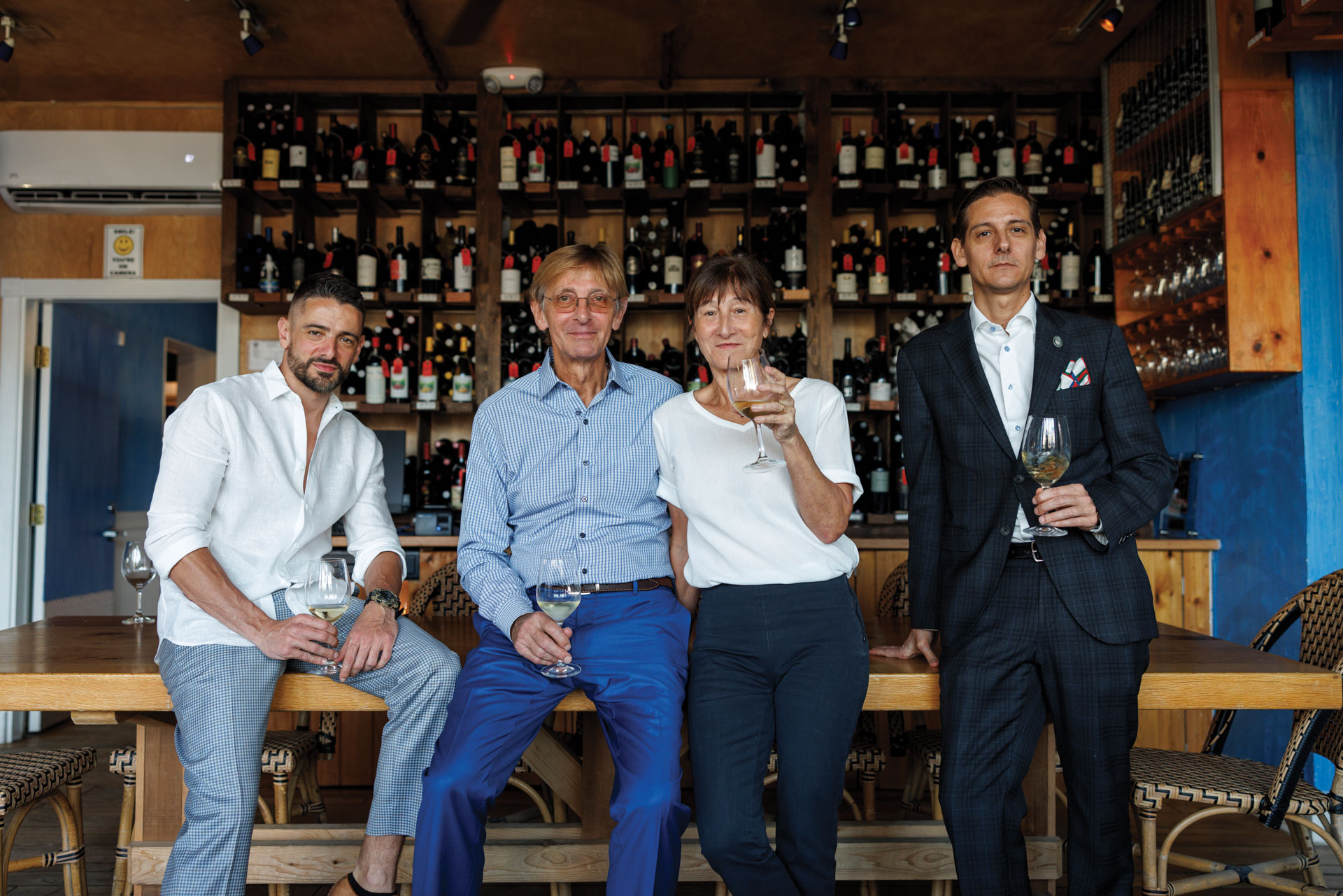
When Jacques and Lysielle Cariot created their alluring Bleu Provence in Naples in 1999, the French natives opened a portal direct from the Florida shores to the sun-kissed South of France. What began as a rather humble homage to their roots has evolved into a legacy restaurant where gastronauts go to lose themselves in a grand culinary voyage that renders geography irrelevant.
The restaurant, awash in crisp white and vibrant blue hues, exudes casual-chic—a French trademark—where the service is attentive without being overbearing or pretentious. And the voluptuous menu highlights a veritable roll call of classics that instantly transport the palate. From herbaceous pistou to plump pan-grilled mussels kissed with bright citrus to provençal fish soup accented with rouille, the signature garlic-saffron-breadcrumb emulsion that accompanies seafood throughout Southern France.
Perhaps even more luminous than the food is the wine program. The selection has become a beacon for oenophiles the world over. When the banner Naples Winter Wine Festival (NWWF)—one of the world’s most illustrious wine auctions—comes to town, the global best-in-class sommeliers and vintners that descend on the Gulf for the festival usually end up at Bleu Provence.
When the restaurant opened, the list contained a mere 30 selections, all from France. Over the years, partially due to guest preferences and partially due to the family’s outright obsession with wine, the list has evolved to include a staggering 5,000 selections and 40,000 bottles from practically every classic wine region in the world. The wine experience at Bleu Provence has earned the team the highly coveted Grand Award from Wine Spectator every year since 2015. The restaurant is one of only 93 in the world and one of four in Florida to hold that honor.
Last year, the couple announced they would be stepping back from day-to-day operations and passing the reins to their sons, Clément, an Advanced Sommelier from the Court of Master Sommeliers (one of about three Advanced Somms in Naples), and Kevin, the restaurant’s general manager, who also helps with the massive undertaking of cataloging the wine inventory. The parents are ready to devote their time to their farm, The Sanctuary, located 45 minutes outside of Naples, where the couple cultivates vegetables, fruit trees, and flocks of chickens and turkeys.
But, rest assured, the restaurant and prestigious wine program are in excellent hands. “Wine was always part of our culture,” Clément says. Meals at his grandmother’s home in Grans, a speck of a village in Provence, were punctuated by bottles lovingly shared by his parents, aunts and uncles. He spent his childhood playing in the family’s small wine cellar, captivated by the old bottles. His first wine memory was at age 7. “I remember one Sunday having a big family dinner, a bottle was being shared, and I was running around the table. Jacques stopped me and said, ‘Stop, you need to respect this.’ So I tried it. It was a Château Lafite Rothschild,” he says of the prestigious, centuries-old producer, known for crafting some of the finest and most expensive reds in the world.
Ever since Bleu Provence opened when Clément was 17, he has had his hands in the family business, working every position on the floor. At age 24, while he was a server, a guest at the bar beckoned him over and said, “Here, don’t taste this, just smell it—tell me what it is.” Clément had never done a blind tasting before. “I said it was a Côte-Rôtie, which was correct. He asked me to name the producer. It was familiar, a wine I had drunk before. I said René Rostaing. And I was right.”
The experience was a watershed moment. Clément started getting more serious about wine. By 2007, he had taken over the wine program. Under his direction, the wine program has doubled—to the point that the family has had to procure off-site storage for the surplus of their battalion of bottles. The restaurant cellar has also grown alongside the collection. At first, Clément recalls, the wines all reached eye level and shared space with an office for the team. Over time, bottles overtook the office, every square inch of wall, and eventually, the next-door space, making for the handsome, wood-clad, 1,300-square-foot masterpiece.
Now, the mere organization of the stock requires savant-level clarity. “We gave every spot where we store the wine a geographic location number. On the list, every wine has a 6-digit number next to it. And we use that to go and locate the wine immediately in the cellar. We have it divided by area, rows, and columns. It’s become like a game of Battleship,” Clément says.
Of course, you’ll find examples of some of the great wines of the world across the list. White Burgundy, the ultimate French chardonnay, is Clément’s personal favorite, and the Big Boys are all present, from Domaine Leroy Corton-Charlemagne to Roulot to Raveneau. But the inherent beauty of this modern collection lies in the surprises, such as the dedication to lower-alcohol wines, natural wines, and a deep roster of lesser-sung expressions and appellations, such as red Sancerre, idiosyncratic pours of France’s Jura region, and European-style California vinifications, like Ceritas chardonnay and pinot noir. “I’m very proud of all the Provence wine we have,” Clément adds. “One of my favorites is Château Simone. Each of their wines brings you a piece of the flavors of Provence: garrigue, lavender, peaches, apricots, a bit of black olive. It really tastes like Provence.”
Great restaurants strive to transport guests, to exude a sense of place. And the Cariot family manages that feat seemingly effortlessly. No passport required.
The post Bleu Provence Owners Pass the Family Torch appeared first on Gulfshore Life.
]]>
When Jacques and Lysielle Cariot created their alluring Bleu Provence in Naples in 1999, the French natives opened a portal direct from the Florida shores to the sun-kissed South of France. What began as a rather humble homage to their roots has evolved into a legacy restaurant where gastronauts go to lose themselves in a grand culinary voyage that renders geography irrelevant.
The restaurant, awash in crisp white and vibrant blue hues, exudes casual-chic—a French trademark—where the service is attentive without being overbearing or pretentious. And the voluptuous menu highlights a veritable roll call of classics that instantly transport the palate. From herbaceous pistou to plump pan-grilled mussels kissed with bright citrus to provençal fish soup accented with rouille, the signature garlic-saffron-breadcrumb emulsion that accompanies seafood throughout Southern France.
Perhaps even more luminous than the food is the wine program. The selection has become a beacon for oenophiles the world over. When the banner Naples Winter Wine Festival (NWWF)—one of the world’s most illustrious wine auctions—comes to town, the global best-in-class sommeliers and vintners that descend on the Gulf for the festival usually end up at Bleu Provence.
When the restaurant opened, the list contained a mere 30 selections, all from France. Over the years, partially due to guest preferences and partially due to the family’s outright obsession with wine, the list has evolved to include a staggering 5,000 selections and 40,000 bottles from practically every classic wine region in the world. The wine experience at Bleu Provence has earned the team the highly coveted Grand Award from Wine Spectator every year since 2015. The restaurant is one of only 93 in the world and one of four in Florida to hold that honor.
Last year, the couple announced they would be stepping back from day-to-day operations and passing the reins to their sons, Clément, an Advanced Sommelier from the Court of Master Sommeliers (one of about three Advanced Somms in Naples), and Kevin, the restaurant’s general manager, who also helps with the massive undertaking of cataloging the wine inventory. The parents are ready to devote their time to their farm, The Sanctuary, located 45 minutes outside of Naples, where the couple cultivates vegetables, fruit trees, and flocks of chickens and turkeys.
But, rest assured, the restaurant and prestigious wine program are in excellent hands. “Wine was always part of our culture,” Clément says. Meals at his grandmother’s home in Grans, a speck of a village in Provence, were punctuated by bottles lovingly shared by his parents, aunts and uncles. He spent his childhood playing in the family’s small wine cellar, captivated by the old bottles. His first wine memory was at age 7. “I remember one Sunday having a big family dinner, a bottle was being shared, and I was running around the table. Jacques stopped me and said, ‘Stop, you need to respect this.’ So I tried it. It was a Château Lafite Rothschild,” he says of the prestigious, centuries-old producer, known for crafting some of the finest and most expensive reds in the world.
Ever since Bleu Provence opened when Clément was 17, he has had his hands in the family business, working every position on the floor. At age 24, while he was a server, a guest at the bar beckoned him over and said, “Here, don’t taste this, just smell it—tell me what it is.” Clément had never done a blind tasting before. “I said it was a Côte-Rôtie, which was correct. He asked me to name the producer. It was familiar, a wine I had drunk before. I said René Rostaing. And I was right.”
The experience was a watershed moment. Clément started getting more serious about wine. By 2007, he had taken over the wine program. Under his direction, the wine program has doubled—to the point that the family has had to procure off-site storage for the surplus of their battalion of bottles. The restaurant cellar has also grown alongside the collection. At first, Clément recalls, the wines all reached eye level and shared space with an office for the team. Over time, bottles overtook the office, every square inch of wall, and eventually, the next-door space, making for the handsome, wood-clad, 1,300-square-foot masterpiece.
Now, the mere organization of the stock requires savant-level clarity. “We gave every spot where we store the wine a geographic location number. On the list, every wine has a 6-digit number next to it. And we use that to go and locate the wine immediately in the cellar. We have it divided by area, rows, and columns. It’s become like a game of Battleship,” Clément says.
Of course, you’ll find examples of some of the great wines of the world across the list. White Burgundy, the ultimate French chardonnay, is Clément’s personal favorite, and the Big Boys are all present, from Domaine Leroy Corton-Charlemagne to Roulot to Raveneau. But the inherent beauty of this modern collection lies in the surprises, such as the dedication to lower-alcohol wines, natural wines, and a deep roster of lesser-sung expressions and appellations, such as red Sancerre, idiosyncratic pours of France’s Jura region, and European-style California vinifications, like Ceritas chardonnay and pinot noir. “I’m very proud of all the Provence wine we have,” Clément adds. “One of my favorites is Château Simone. Each of their wines brings you a piece of the flavors of Provence: garrigue, lavender, peaches, apricots, a bit of black olive. It really tastes like Provence.”
Great restaurants strive to transport guests, to exude a sense of place. And the Cariot family manages that feat seemingly effortlessly. No passport required.
The post Bleu Provence Owners Pass the Family Torch appeared first on Gulfshore Life.
]]>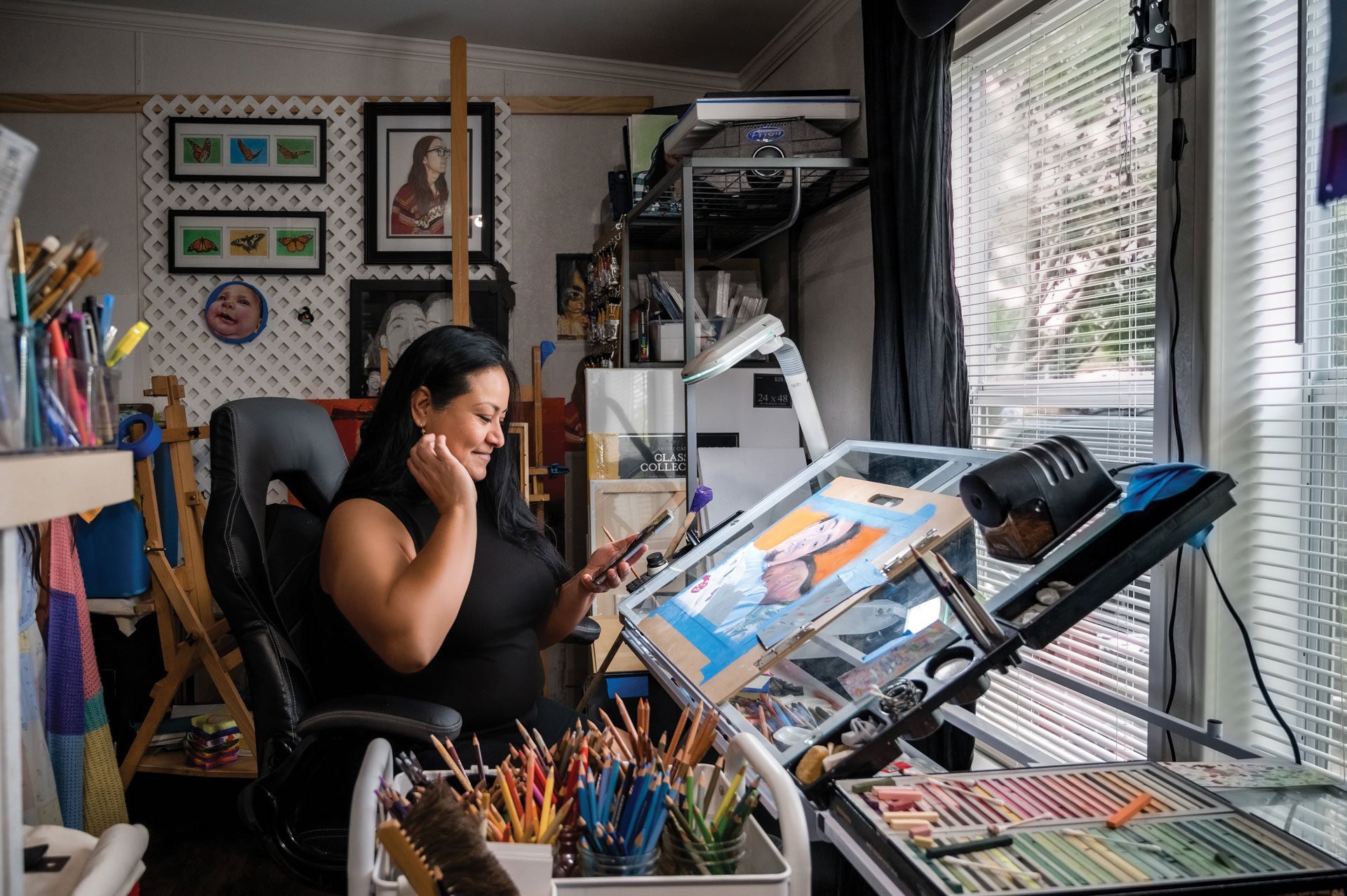
Years had passed since she used these muscles, but it felt natural. The piece was just a simple sketch of a plant cell for her son’s homework, but Martha Maria Cantu was instantly lost in the process. Once finished, the young mother looked up to see a pair of saucer-sized eyes staring at the page. “He called over his siblings and said, ‘Look, look what Mom did! She’s like a professional artist,’ and I was like, ‘What do you mean? I am a professional artist,’” Martha says, chuckling at the memory.
The kids watched in awe as Martha pulled drawings and paintings that hadn’t seen light in years. Some sported blue ribbons or newspaper clippings. Questions came pouring from every direction. Did she miss it? Yes, desperately. Why didn’t she draw anymore? She didn’t know.
That was about eight years ago. When you drive into Immokalee today, you’ll see a welcome sign Martha Maria Cantu painted that pays tribute to her community, with calloused hands enveloping a young seedling against a background of farmland, football fields, encroaching tides and a pulsing sunset. Her most prominent mural, three panels depicting Everglades wildlife, migrant farmworkers and early Florida cattle drivers, stretches along the side wall of Main Street’s 7-11 in a graphic riff on expressionist style. Through the public art commissions and exhibits across Southwest Florida, Martha has become one of the breakout artists of Immokalee’s quietly growing arts scene. And portraits are the artist’s calling card.
It all begins with the eyes. Light-bleached vacancies shatter irises that burst with fuchsia, amber and goldenrod, adding dimension to darker hues. Shadows and reflections creep out from black, cavernous pupils. The subtle curvature of each eyelid signals uncanny emotion. “Once I get [the eyes] down, I know I’ve got this,” she says. “Everything else is a blur.”
Despite commonalities, the population in Martha’s hometown is no monolith—artistic, agricultural, medical, culinary and educational aspirations abound alongside rigid traditionalism, even when opportunity feels scarce. Complexity and nuance characterize the people of Immokalee and, in turn, Martha’s portraiture.
Crafted in her makeshift bedside studio with colored pencils, pastels, acrylic paint or oils, her arresting portraits depict people she sees every day and people she admires. The artist sees a person’s story reflected in their eyes and the lines etched into their skin—two of the most prominent and detailed aspects of her representational work. She is drawn to subjects whose faces are marked with years of toil and struggle but whose eyes portray kindness and strength. Living in Immokalee, where economic strain and limited resources are met with limitless resolve, subjects like these are often close at hand.
When Martha heard the story of an older man known as Don Andres, she saw all those magnetic qualities in his eyes. For decades, Don Andres has worked odd jobs picking up cans or laboring in neighbors’ yards and sent what money he made back home to Mexico to support a wife he has not seen in nearly 40 years. Martha Maria Cantu does not glamorize her subjects. In his portrait, Don Andres’ skin is sun-worn and cracked, and his wardrobe, a tattered baseball cap and sun-bleached T-shirt, sags with daily use. Beneath the oasis of mottled shade cast by his favorite tree in Immokalee, the man’s gaze is burdened but steady.
Martha was born in Mexico and immigrated to the United States when she was 4. She moved here with her mother, a woman whose cruel and exacting nature would sculpt her daughter’s artistic journey. Martha’s stepfather came into her life around this time, too. He didn’t speak much Spanish, and as a child, Martha spoke little English. In the evenings, while her mother was at work, Martha would sit silently nearby—not so close that she’d get in the way but near enough to not feel alone—as he watched wrestling on TV. Today, she remembers the gruff and kind-hearted man as “Dad,” but at 7, she didn’t know if he could be trusted. Few people in her life had proven worthy of her faith.
In an effort to connect, Martha showed her father a drawing of the Jesus painting that hung on their wall in pious observation. In his best pidgin, her dad told her not to interrupt his wrestling again until her drawing looked just like the picture. Without instruction or books or anything but an ingrained attention to detail, the child set to work. “I don’t remember how long it took—hours, days, weeks—but I got it to look just like what was on the wall. I showed my dad, and he was astonished,” she says. “He didn’t need to say anything—that was it, and I was hooked.”
Finding approval at home never came easy, but at school, the young artist’s skills were celebrated—and nurtured. She remembers the art teachers who pushed her to enter competitions and got her an interview with Ringling College of Art and Design in Sarasota. “Winning awards, being on the news and in magazines—that was great, but it was just never enough for Mother,” she says.
With only a third-grade education, Martha’s mother did not care for her straight-As and art competition victories. She could be both verbally and physically abusive, and when these methods of discipline failed to faze her daughter, she sprinted to Martha’s room and destroyed every piece of artwork she could find.
The opportunity to attend Ringling felt like the beginning of a new chapter, one where she could silence internal and external voices of doubt. After weeks of courting the young artist over the phone and through email, the dean of students met Martha Maria Cantu face-to-face. As a woman of color from a home that rarely had air conditioning, much less pricey art supplies, Martha was not their typical demographic. Her acceptance was rescinded. Martha would be better suited for community college, the director said. “He looked down on me, not because of what I’ve done or what I could do, but just because of who I was and what I looked like,” she says.
After the rejection, Martha married, had children and gained stepchildren—mothering 10 altogether. The dormant artist focused on creating a different home from the one that raised her. As her children grew, they reciprocated her love and support, pushing their reserved mother to rebuke the fear of rejection and embrace her talents. The artists who inspire Martha are not Renaissance greats or vanguards of modernism; they are her children, who will not allow her to quit again. Among her kids—from elementary to post-graduate age—several aspire to artistry, like their mother.
Martha hangs their clay figurines and Japanese manga panels alongside her own artwork; their creations fill her studio with levity and joy. “I really want to inspire the younger kids. I didn’t have that inspiration or that outlet [growing up], and I want to give that to them—not only with my artwork but also my home,” she says.
Recently, her son asked for a spare sketchbook for a friend who couldn’t afford materials. She happily sent it over as a birthday gift. When Martha came to pick the kids up from school soon after, the boy ran over to her, nervous and excited to flip through the sketchbook and show her his latest work. One of the sketches had won him a $2,000 prize. “If they don’t have that person pushing them, I’m here, I’ll listen,” she says. “I have the time. I have a bunch of kids, but I have room. I love to cook. I do the cleaning like it’s nothing. I’ll be your mom. I’ll be that.”
The post Meet One of Southwest Florida’s Top Portrait Artists appeared first on Gulfshore Life.
]]>
Years had passed since she used these muscles, but it felt natural. The piece was just a simple sketch of a plant cell for her son’s homework, but Martha Maria Cantu was instantly lost in the process. Once finished, the young mother looked up to see a pair of saucer-sized eyes staring at the page. “He called over his siblings and said, ‘Look, look what Mom did! She’s like a professional artist,’ and I was like, ‘What do you mean? I am a professional artist,’” Martha says, chuckling at the memory.
The kids watched in awe as Martha pulled drawings and paintings that hadn’t seen light in years. Some sported blue ribbons or newspaper clippings. Questions came pouring from every direction. Did she miss it? Yes, desperately. Why didn’t she draw anymore? She didn’t know.
That was about eight years ago. When you drive into Immokalee today, you’ll see a welcome sign Martha Maria Cantu painted that pays tribute to her community, with calloused hands enveloping a young seedling against a background of farmland, football fields, encroaching tides and a pulsing sunset. Her most prominent mural, three panels depicting Everglades wildlife, migrant farmworkers and early Florida cattle drivers, stretches along the side wall of Main Street’s 7-11 in a graphic riff on expressionist style. Through the public art commissions and exhibits across Southwest Florida, Martha has become one of the breakout artists of Immokalee’s quietly growing arts scene. And portraits are the artist’s calling card.
It all begins with the eyes. Light-bleached vacancies shatter irises that burst with fuchsia, amber and goldenrod, adding dimension to darker hues. Shadows and reflections creep out from black, cavernous pupils. The subtle curvature of each eyelid signals uncanny emotion. “Once I get [the eyes] down, I know I’ve got this,” she says. “Everything else is a blur.”
Despite commonalities, the population in Martha’s hometown is no monolith—artistic, agricultural, medical, culinary and educational aspirations abound alongside rigid traditionalism, even when opportunity feels scarce. Complexity and nuance characterize the people of Immokalee and, in turn, Martha’s portraiture.
Crafted in her makeshift bedside studio with colored pencils, pastels, acrylic paint or oils, her arresting portraits depict people she sees every day and people she admires. The artist sees a person’s story reflected in their eyes and the lines etched into their skin—two of the most prominent and detailed aspects of her representational work. She is drawn to subjects whose faces are marked with years of toil and struggle but whose eyes portray kindness and strength. Living in Immokalee, where economic strain and limited resources are met with limitless resolve, subjects like these are often close at hand.
When Martha heard the story of an older man known as Don Andres, she saw all those magnetic qualities in his eyes. For decades, Don Andres has worked odd jobs picking up cans or laboring in neighbors’ yards and sent what money he made back home to Mexico to support a wife he has not seen in nearly 40 years. Martha Maria Cantu does not glamorize her subjects. In his portrait, Don Andres’ skin is sun-worn and cracked, and his wardrobe, a tattered baseball cap and sun-bleached T-shirt, sags with daily use. Beneath the oasis of mottled shade cast by his favorite tree in Immokalee, the man’s gaze is burdened but steady.
Martha was born in Mexico and immigrated to the United States when she was 4. She moved here with her mother, a woman whose cruel and exacting nature would sculpt her daughter’s artistic journey. Martha’s stepfather came into her life around this time, too. He didn’t speak much Spanish, and as a child, Martha spoke little English. In the evenings, while her mother was at work, Martha would sit silently nearby—not so close that she’d get in the way but near enough to not feel alone—as he watched wrestling on TV. Today, she remembers the gruff and kind-hearted man as “Dad,” but at 7, she didn’t know if he could be trusted. Few people in her life had proven worthy of her faith.
In an effort to connect, Martha showed her father a drawing of the Jesus painting that hung on their wall in pious observation. In his best pidgin, her dad told her not to interrupt his wrestling again until her drawing looked just like the picture. Without instruction or books or anything but an ingrained attention to detail, the child set to work. “I don’t remember how long it took—hours, days, weeks—but I got it to look just like what was on the wall. I showed my dad, and he was astonished,” she says. “He didn’t need to say anything—that was it, and I was hooked.”
Finding approval at home never came easy, but at school, the young artist’s skills were celebrated—and nurtured. She remembers the art teachers who pushed her to enter competitions and got her an interview with Ringling College of Art and Design in Sarasota. “Winning awards, being on the news and in magazines—that was great, but it was just never enough for Mother,” she says.
With only a third-grade education, Martha’s mother did not care for her straight-As and art competition victories. She could be both verbally and physically abusive, and when these methods of discipline failed to faze her daughter, she sprinted to Martha’s room and destroyed every piece of artwork she could find.
The opportunity to attend Ringling felt like the beginning of a new chapter, one where she could silence internal and external voices of doubt. After weeks of courting the young artist over the phone and through email, the dean of students met Martha Maria Cantu face-to-face. As a woman of color from a home that rarely had air conditioning, much less pricey art supplies, Martha was not their typical demographic. Her acceptance was rescinded. Martha would be better suited for community college, the director said. “He looked down on me, not because of what I’ve done or what I could do, but just because of who I was and what I looked like,” she says.
After the rejection, Martha married, had children and gained stepchildren—mothering 10 altogether. The dormant artist focused on creating a different home from the one that raised her. As her children grew, they reciprocated her love and support, pushing their reserved mother to rebuke the fear of rejection and embrace her talents. The artists who inspire Martha are not Renaissance greats or vanguards of modernism; they are her children, who will not allow her to quit again. Among her kids—from elementary to post-graduate age—several aspire to artistry, like their mother.
Martha hangs their clay figurines and Japanese manga panels alongside her own artwork; their creations fill her studio with levity and joy. “I really want to inspire the younger kids. I didn’t have that inspiration or that outlet [growing up], and I want to give that to them—not only with my artwork but also my home,” she says.
Recently, her son asked for a spare sketchbook for a friend who couldn’t afford materials. She happily sent it over as a birthday gift. When Martha came to pick the kids up from school soon after, the boy ran over to her, nervous and excited to flip through the sketchbook and show her his latest work. One of the sketches had won him a $2,000 prize. “If they don’t have that person pushing them, I’m here, I’ll listen,” she says. “I have the time. I have a bunch of kids, but I have room. I love to cook. I do the cleaning like it’s nothing. I’ll be your mom. I’ll be that.”
The post Meet One of Southwest Florida’s Top Portrait Artists appeared first on Gulfshore Life.
]]>